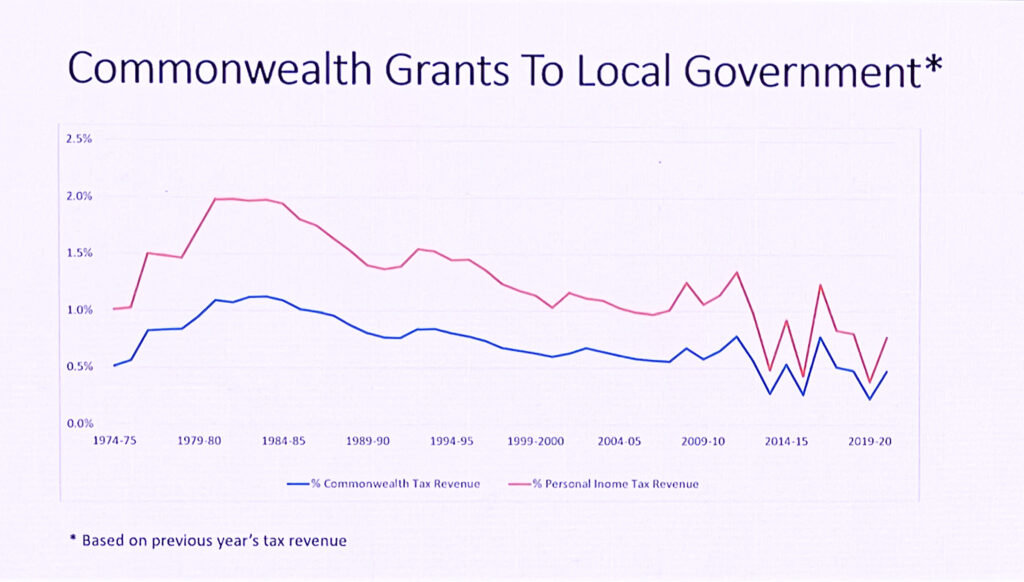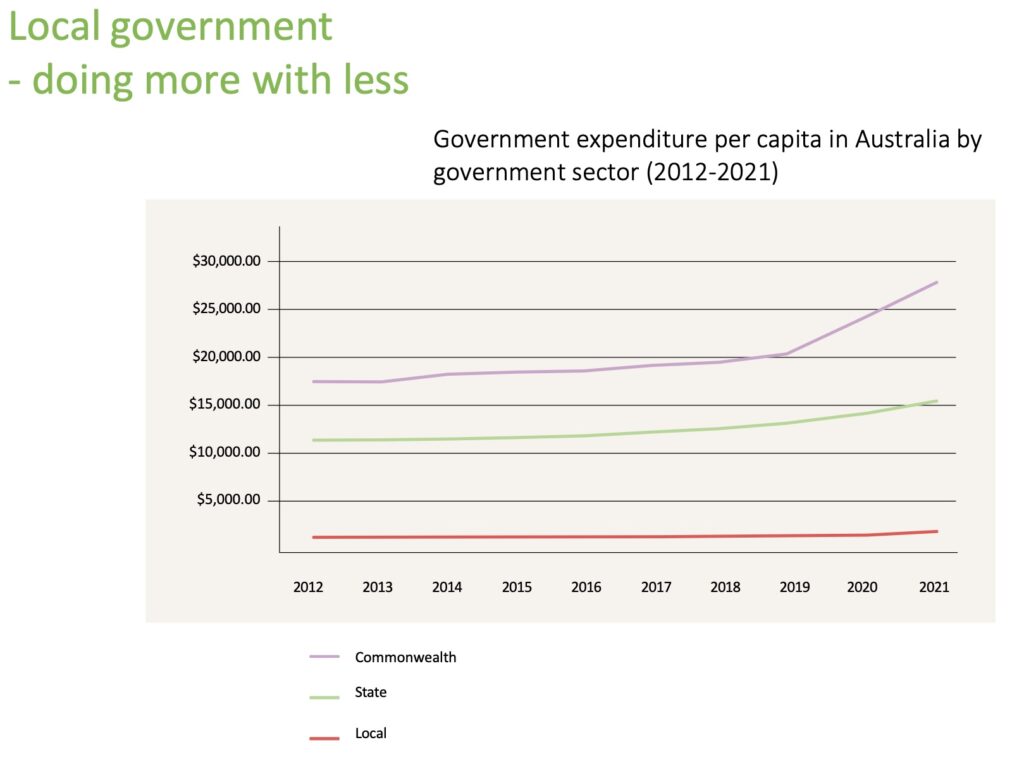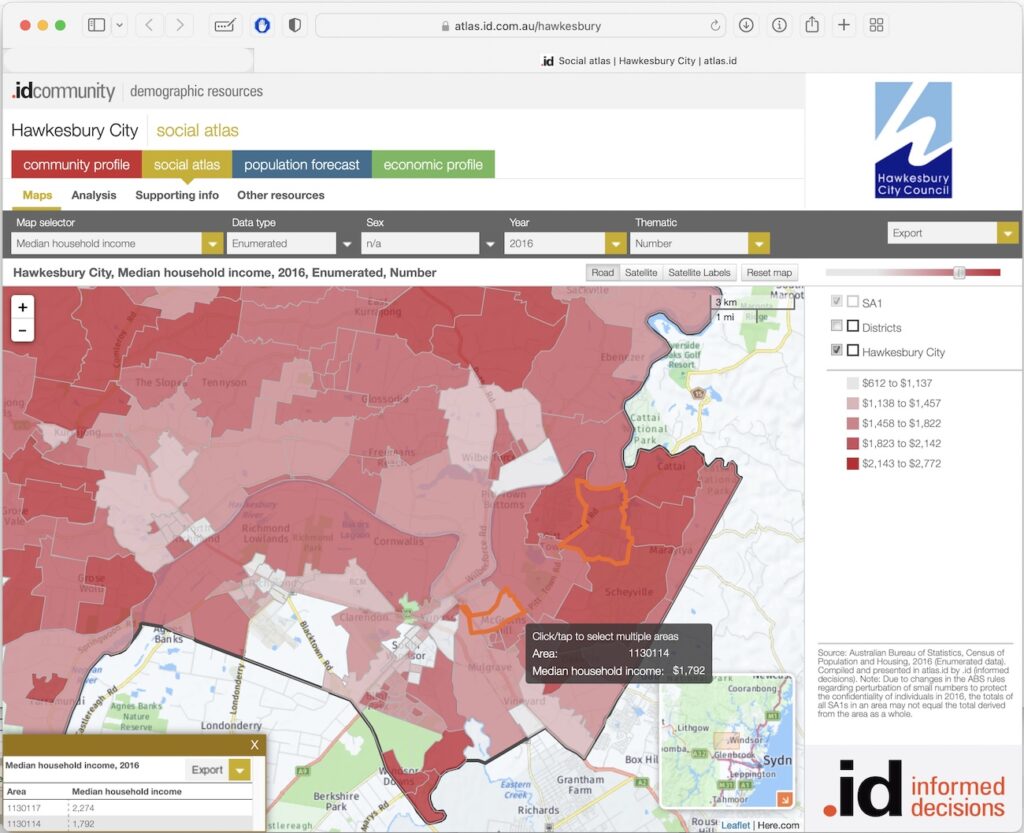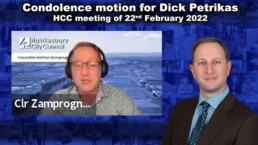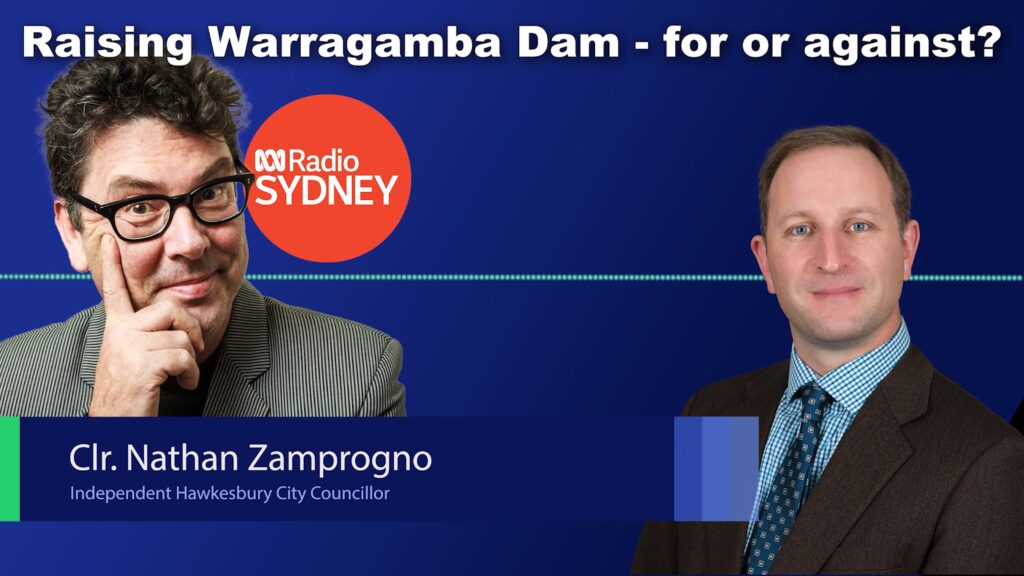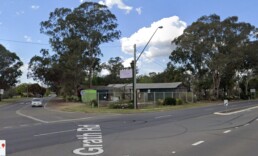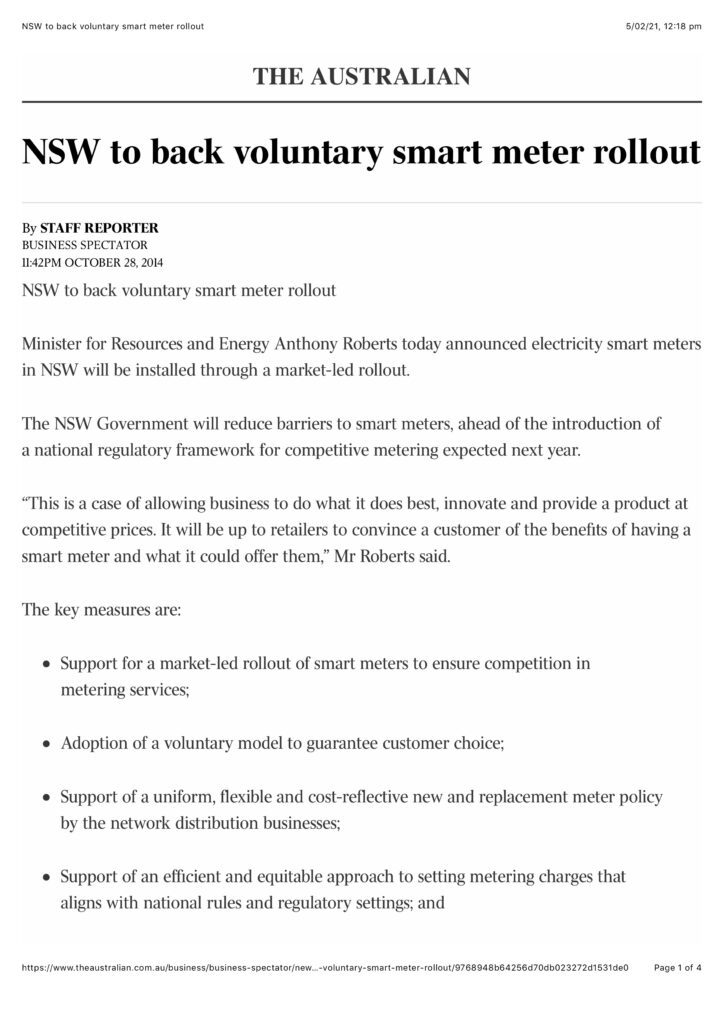Uncategorized
Should we lower Warragamba Dam instead of raising it?
Last week Council met for the first time since the July floods. The Mayor advanced a motion that calls on the State Government to change legislation regulating the operation of Warragamba Dam to permit the Dam to be lowered in times of likely high-rainfall which will provide a degree of flood mitigation ability.
I supported the motion, but I want to be very clear that lowering the operating level of the dam is not a substitute for raising the dam wall, which remains the best way to properly mitigate floods. Lowering the dam level might have taken 20-60cm off the level of the flood. Raising the dam would have taken off 3.5 metres, based on the smaller March 2021 flood.
As I say here, climate change will deal us times of greater variability of weather in coming years. Longer periods of flood and longer periods of drought. The reductions being sought by some at our meeting last Tuesday would have let the whole dam run dry prior to the end of the last drought in February 2020. That's just as irresponsible. I see a lot of people advancing positions in the teeth of scientific evidence they're wrong, and that's no way for us to get to the best solution.
Whether to raise or lower the Dam was also the subject of an excellent story this week on Channel 9's A Current Affair.
The Australian Local Government Assembly - What Hawkesbury can learn from a bigger picture, especially as it relates to natural disasters
Just before the floods overtook us all, I attended the Australian Local Government Assembly (ALGA) down in Canberra, an annual conference that pulls together the 537 local governments around Australia.
Our focus is the bigger picture of local government as it relates to the nation as a whole – a perspective that I believe my colleagues often misunderstand because they express little interest in the subject. Only Councillor Lyons-Buckett and Councillor Wheeler have been regular attendees with me over the last six years.
Presciently, a lot of what we heard about was about the increasing cost of natural disasters, and the disproportionate burden placed on Councils in the repair and cleanup.
The evidence is clear: Local Governments are the most disadvantaged tier of Government in Australia. Councils directly take in only 3.5% of all taxation revenue levied across all three tiers of government, and yet Local Governments are responsible for 24% of all public assets and service provision, not to mention planning how our communities can grow and thrive. The balance has to come from a patchwork of grants and programs from State and Federal governments which are neither predictable over time, and which have slipped further and further behind costs as the years have passed.
I'm a believer in the principle of subsidiarity – that decisions consequential to how we live are best made by those who are closest to those effected by any policy. So, I am happy to join my voice to my colleagues in calling to other tiers of government to set things right, both as a crucial reform, and as a nation building exercise.
The video above is my report about what I learned – I pushed through a reform to Council which demanded Councillors give an account to you after they are sent to conferences to prove they were paying attention (the Labor and Liberal Councillors have disappointingly since rescinded that accountability measure). And below I give a small selection of further data gained from conference presentations:
The first relevant figure is that the support given to all Local Governments from Federal taxation revenue has about halved over the last 40 years. It used to be about 1% of all Federal Taxation revenue and now sits at about 0.55%. This includes Roads to Recovery funding and Federal Assistance Grants.
The only revenue Councils can levy directly are through Council rates. In NSW this is constrained by the infamous "Rate Peg" - This year Councils were asked to raise rates by only 0.8% when inflation and costs were rising at a rate above 5% p.a. As a share of all taxation revenue raised in Australia, we've slipped badly despite millions of dollars of cost-shifting to Councils.
Meanwhile, government expenditure per capita has ballooned over the last decade, while the Local Government's ability to invest has remained static. We know Council's get a lot of flack for poor service and potholed roads, but in objective terms, we have been squeezed and squeezed and run an increasingly frugal outfit.
This conclusion is backed up by International data which shows that Local Governments in Australia are very poorly resourced compared to other nations. The above graph comes from a New Zealand study (thus the emphasis), but Australia is there, all the way over at the right, and small fraction compared to many other developed nations.
Local government however remains easily the most trusted tier of government in Australia, and especially among young people.
Lastly, I want to turn to what we heard about the increasing costs of natural disasters, especially in the light of what has just struck our community, again, with catastrophic effect.
We received a briefing from Deloitte which shows starkly what we have been through begins to look like when extrapolated to the largest scale.
Natural disasters are costing our economy $38 Billion in each and every year, and those costs are expected to rise to more than double that within 30 years – both as a result of climate change but also if we fail to adapt, mitigate and improve the resilience of our communities to disaster. The Hawkesbury is clearly at the coal face of this challenge. We were told that 97% of all natural disaster funding is spent after disasters have struck, and yet only 3% of funds are spent proactively to mitigate those events (such as raising Warragamba Dam!) or in building resilience into our communities and infrastructure.
Australia stands to realise a $380BN economic dividend resulting from proactive resilience-planning and climate-adaptation initiatives, and potentially create over 73,000 full time jobs (by 2050) if we begin to act now, in sectors as varied as manufacturing, transport, construction, services and the retail sector.
I attended a briefing from the National Recovery and Resilience Agency. Unaware at the time of what was about to visit us, I pleaded with them to address all the deficiencies in disaster preparedness and response we've just seen again.
I said that since 2020, we have had the worst bushfires in history, a pandemic, and multiple floods, the last of which was the worst in 44 years.
In March, 800 houses on our floodplain were flooded, but 25,000 could be at risk in a worse one, and that this is statistically a certainty over time.
I pointed out that the agency has made a $50m pledge in the 2021-22 “National Flood Mitigation Infrastructure Program” to fund 37 different projects around the country, and yet not a single dollar is earmarked for spending in the Hawkesbury-Nepean – the largest unprotected floodplain in the nation.
I told them that after floods in 2020, 2021 and March 2022, the State government had promised landowners fronting our rivers a streamlined process to perform urgent remedial works to stop their homes, sheds and farms from slumping into the river. Over a year later, we're still waiting despite Council pleading with State ministers, and the inability of landowners to act because red tape imposed by the State government has had catastrophic effects.
Those landowners tell me it would be both cheaper and faster to perform the works illegally and cop a fine than to go through the red tape of commissioning reports in aid of mandatory DA’s that may well cost more than the works those reports are asking to perform. It's not good enough.
I will continue to fight for these urgent reforms, and invite you to follow me on social media for regular updates.
The Hawkesbury-Nepean flood of July 2022 – the worst since 1978
July 5th 2022 represented the worst day of flooding in the Hawkesbury in 44 years.
This flood exceeded 13.93m, beating both the March flood (13.71m) and the 2021 flood (12.91m). You would have to go back to 1978 (14.5m) to see a worse flood. The 1867 flood was 19.6m. A "one in a hundred" flood is 17.3m, each measured at the Windsor gauge.
I toured the district, commiserated with locals, and took note of what I saw. This video represents the waters as they peaked. Councillors are being briefed daily by Council staff and we're proactive in guiding the response to the emergency.
I am reminded yet again how magnificently we stand by one another in times of trial. Our community is strong, and the only way we can get through this, is together.
There is one common misunderstanding that's worth clearing up, because I hear it very frequently.
Warragamba is not a flood mitigation dam. It was built as a water storage dam in 1960 and legally cannot be deliberately operated at below 100% capacity in the sense of dumping water overboard in anticipation of a rain event, or permanently operating it at a lower capacity. This is unlike other city dams like the Wivenhoe Dam in Brisbane which has a permanent 'air gaps' to act as a buffer in times of flood. Wivenhoe's water storage capacity is 1160 gigalitres but its air gap is a further 1967 gigalitres. IN other words, two thirds of its capacity is a flood buffer.
Warragamba's current capacity is 2031 gigalitres, and the plan to raise it by 14m will add about 1000 gigalitres of emergency storage.
Some have argued that the water level could be drawn down from 100% as the result of a long range forecast for rain, anticipating an East Coast Low for example. Others argue the permanent level of the dam should be lowered and that this is equivalent to the kind of mitigation that raising the dam would confer.
However, this would not confer a sufficient degree of mitigation to be worthwhile. And here's the analysis of flood hydrology that proves it:

If the dam level had been drawn down just before the 2021 flood, the resulting flood height would have been only 20cm lower.
If the dam was permanently kept lower by as much as 5m, it would have made a 60cm difference. Any more and Sydney's drinking water would be imperilled. Had the water supply been lowered by 5 metres in 2016 for example, the dam storage would have dropped to around 26% in February 2020 at the end of that drought – a critically low level, even lower than during the Millennium drought when the storage reached 32%.
If a raised dam had already been in place, 500 of the 600 houses flooded along the Hawkesbury-Nepean floodplain would have been spared since that flood would have been 3.5m lower. And in the events of still-larger floods, the degree of protection grows further.
Only raising Warragamba dam will confer the necessary degree of mitigation. I commend this Infrastructure NSW FAQ and also the NSW Government's post 2021 flood report for more information.
How the community rallied to clean up Pitt Town creeks after the floods
Two months ago I raised the terrible condition of Bardenarang Creek at Pitt Town after the March floods. Friendship Bridge there marks a significant historical site – the place of first meeting between Europeans and Aboriginals in the district in 1791.
Plastic sheeting and debris filled the creek and it was well beyond locals or Council to fix unless there was a significant collaboration of manpower and pooled resources.
It's heartening to see that help has arrived in the form of Disaster Relief Australia, who have combined with Hawkesbury City Council and the Pitt Town Progress Association to resource a four-day blitz on a substantial part of the creek. DRA are a Veteran-led volunteer organisation who help communities in distress at times like these.
I've long been a student of what resilient communities look like, and behold: A local residents group with volunteers and heavy equipment ready to help, Council ready to co-ordinate with skip bins and portaloos (and thanks to Council officer Phillip Bow for his role), and a group like Disaster Relief Australia who bring know-how and corporate philanthropy from the likes of NAB, Allianz, & Salesforce (and many others) contributing manpower and funding. This is the way.
We can only hope that we will not have to repeat this whole exercise again in the coming weeks as the threat of new floods loom over us. Some in our community have been knocked down more than once. Only with help like this can they continue to get back up.
On behalf of the Hawkesbury community, thank you to you all for your heart to help, for your muscle, for your smarts, and for your coin.
Long-delayed road sealing program gets underway
Sky News Australia special report into flooding on the Hawkesbury-Nepean River
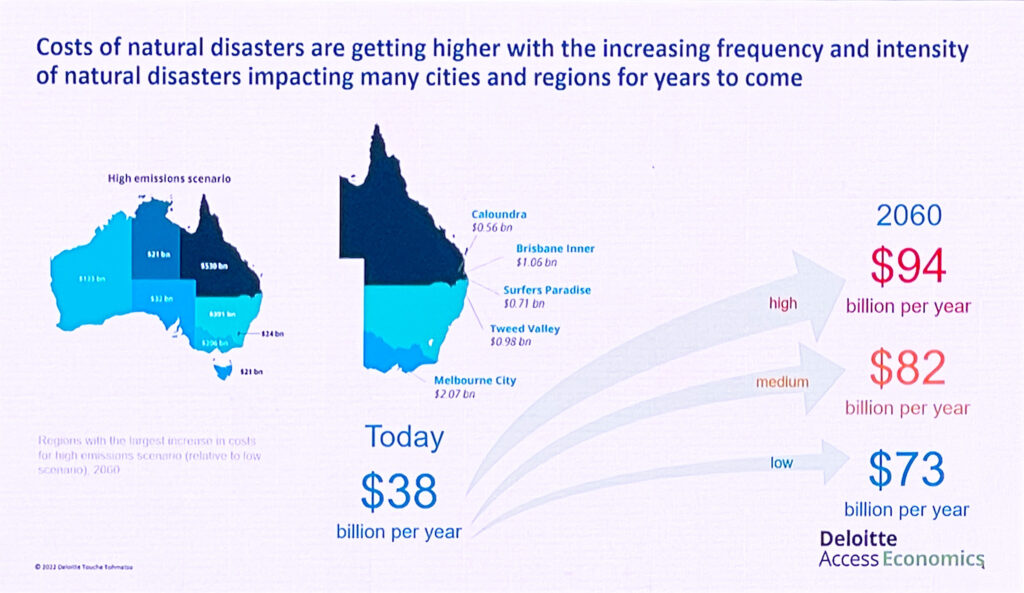
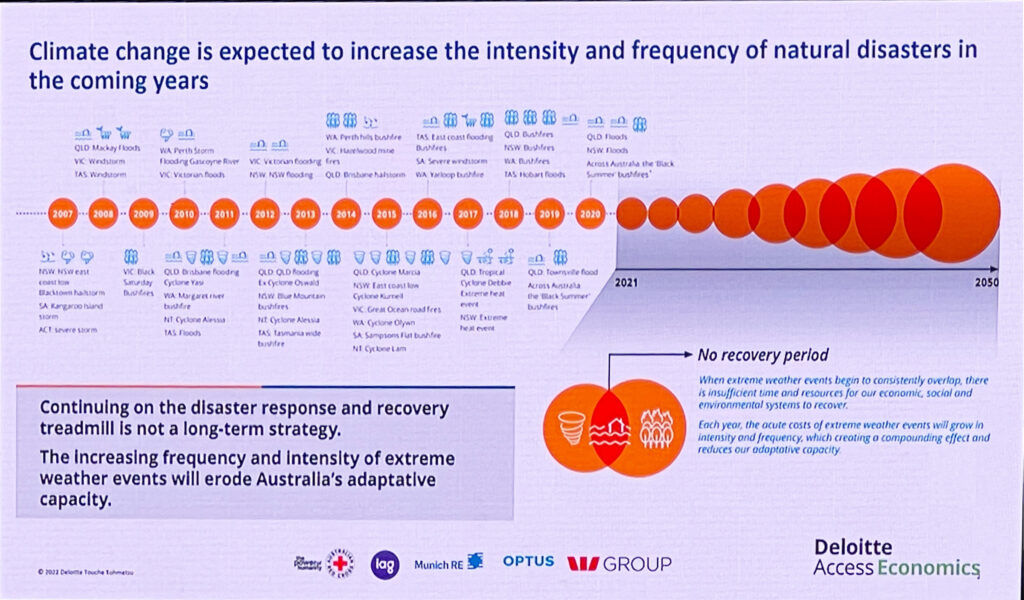
However, raising Warragamba Dam is a necessary part of a larger strategy. In the Flood Emergency Plan our Council adopted in 2020, the maintenance of effective evacuation routes was listed as a critical priority.
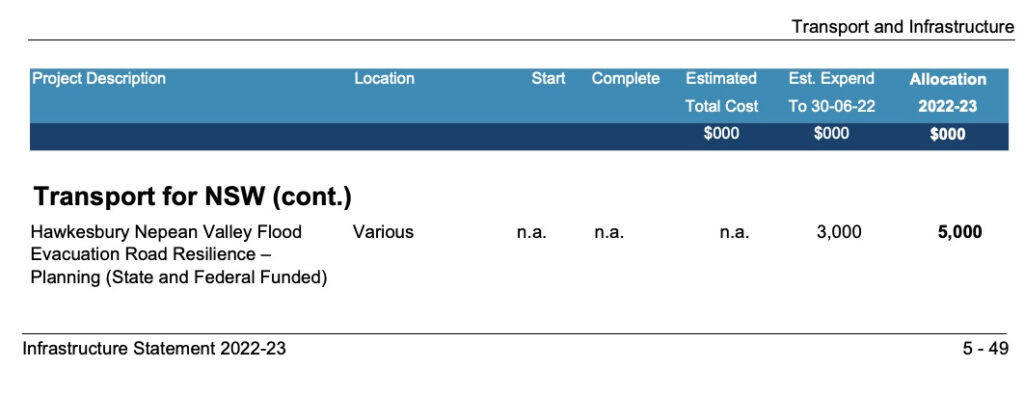
The family home flooded because they live next door to development
James and Nadine lived in Harkness Road in Oakville, squarely in the area we call Vineyard Stage 1, a location of intensive subdivision caused by the North West Growth Sector.
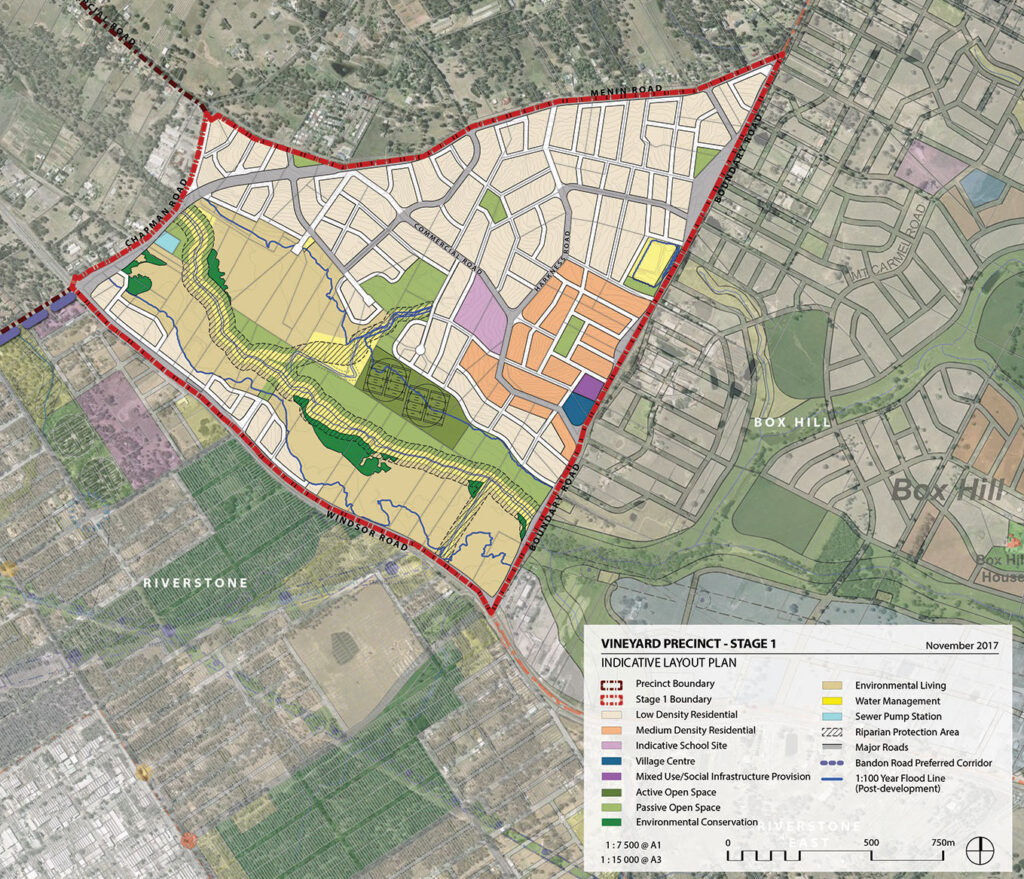
Their home was nearly, but not quite at the top of a hill. The developers over the road had already razed the houses that had stood there since the 1970s – family homes that had stood on acreage properties at the crest of that hill, and had eaten into the land like you'd take the top off an egg.
Prior to the bulldozers arriving, rainwater drained off the top of the hill equally in all directions. But since the excavations began, the hilltop opposite was now a shallow, muddy basin. But that basin now had a spout, and the spout was pointed squarely at James and Nadine's home, which sat at the bottom of a sloping driveway.
When the rains came in March 2022, that water filled the basin, which had been constructed with no sedimentation control, and poured out of its lowest point – the spout opposite their home. A muddy slurry ran through their home to a depth of some inches. James and Nadine's property were ruined, and they estimate the damage into the tens of thousands of dollars. Recent arrivals to the home, they had not yet taken out insurance.
This story is a tragedy. It parallels that of many other Hawkesbury home owners on lower land whose houses were also flooded out by the rising of the river to 13.7m at Windsor, a height not seen since March 1978.
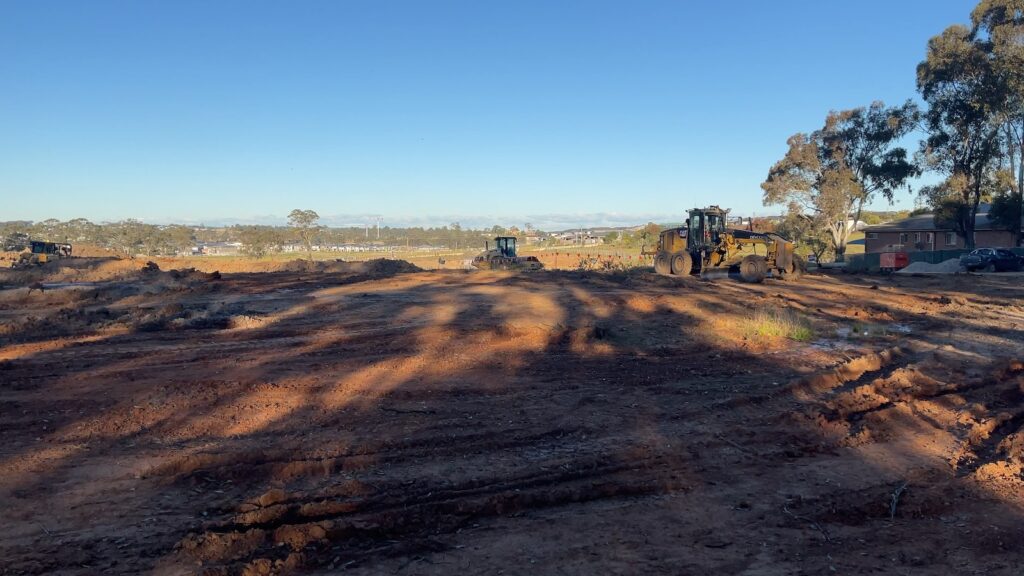
But James and Nadine's story is distinct in two respects. The first is that this house had stood there for decades, and the elevation in Harkness Road meant the property had never flooded before. It was well above the riverbank properties that flooded in early 2021 and March 2022.
The second reason, and the reason James and Nadine have engaged me to advocate for them, was the substandard response they had received from Hawkesbury City Council.
James and Nadine never wanted to go public with their story, until months had elapsed and they came to the conclusion that publicity was the only way they could get answers to their questions.
Timeline:
First week of March - rain event, home flooded.
Second week of March - Council contacted seeking help
25th March - Clr Lyons-Buckett and myself contacted about non-response from Council.
28th March - I attend the Harkness Road property and record video, part of which is in the main video above and which was sent privately to Council staff to lay out the problem clearly.
12th April - Clr Lyons-Buckett and myself speak directly to the General Manager after a Council meeting to ask for a response. One is promised.
20th April and 13th May - Having had no response from Council, Councillors are again asked to chase the matter. I speak to our Director of Planning by phone.
13th May - An email from the General Manager to James and Nadine says "I’ll follow this up with my team and get back to you as soon as I can."
June 3rd - James and Nadine decide to go public given the complete lack of a satisfactory response from Council.
June 14th - The Hawkesbury Post makes a media request directly to Council. It is not answered by date of this publication (June 21st).
Three months without a satisfactory answer. This is not good enough.
As a Councillor, I pledge to represent residents when they have issues with Council. I'm not here to defend Council when the level of customer service they deliver is not up to standard.
Who wears the liability here?
- Is it the developers? They've now written to James and Nadine and told them all communication needs to be through their insurers.
- Is it the contractors? The excavations they performed allowed water to pool on the site and pour through a home that had never flooded before. When I visited the site in March, no sedimentation controls were present. When I visited on June 3rd, I could see they had belatedly been installed.
- Is liability with Council? Were there conditions of consent that were not enforced.
I have been calling for reform within Council, especially in the area of our planning, compliance and enforcement divisions, for some time. This story just underlines for me how chronically under-resourced Council is in this area. I get more comments from ratepayers about this than many other issues.
I am bringing this issue to a wider audience because even as a Councillor I have been unable to get timely answers to my questions. Let's hope this does some good.
Talking with Hawkesbury Business Owner Darren Pead about Windsor Mall
Darren Pead is committed to the economic health of the Hawkesbury, running Guy Stuff, Lollies 'N Stuff and Delicious Desserts – all in Windsor Mall.
He’s also passionate about how we present and promote our town centres, balancing renewal with enhancement of our wonderful heritage.
Council has spent the last three years developing a strategy for renewal in our town centres as part of our participation in the $18.75M Western Parkland City Liveability Program.
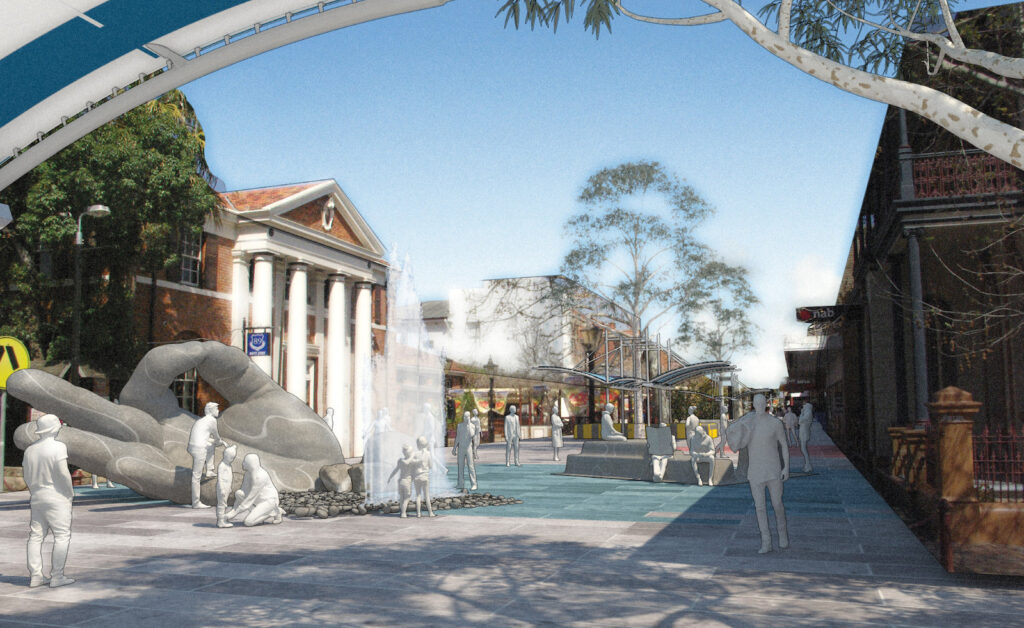
Darren has travelled the world to look at how other historic townships put their heritage front and centre, and asks if we’ve gotten the mix right.
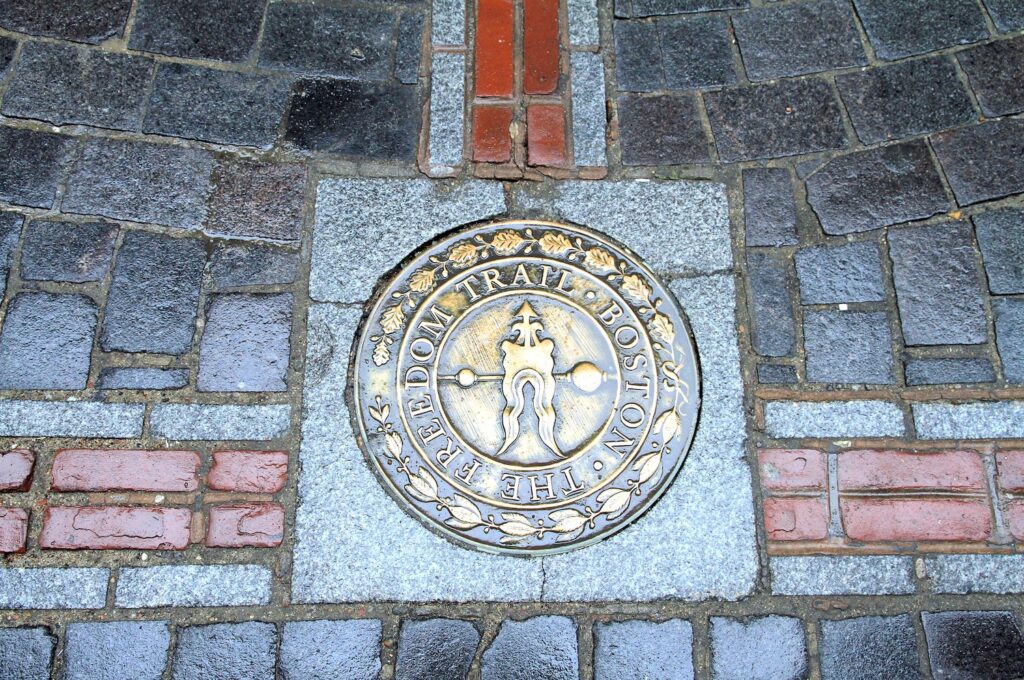

Recently the community has affirmed it wants the rotunda and the gas lanterns preserved and restored in Windsor Mall, but Darren points to the huge proportion of the available budget being lost to just one aspect - uprooting and relaying all the paving, when repairs to the existing paving (badly needed - no argument) could unlock millions to get better value from the project as a whole.
I don’t want to see wrought iron seating replaced with sterile, Westfield-style bland street furniture.

A heritage trail could link Windsor Station to Thompson Square with medallions embedded in the pathways and an extension of heritage-styled lanterns down George St.
Darren and I would like to see the plan - otherwise excellent, given one more pass by Councillors to ensure that the money is spent where it will do the most good.
We sat down and had a chat this week and it makes for a fascinating conversation.
The sorry state of historic Bardenarang Creek, Pitt Town
Pitt Town local Gordon Douglas was on the phone with me, as he often is. "Nathan, have you seen the state of Bardenarang Creek since the floods? It's terrible!"
That afternoon I went to the famous Friendship Bridge on Pitt Town Bottoms Road to see for myself, and saw the reason for his concern.Repeated floods have left the creek in a very sorry state, with tattered plastic sheets from local farms spectrally draped in all the trees and choking the waterway.
The site has significant historic importance too. This was the site of the very first meeting between europeans and the Darug Aborigines in 1791. When I helped locals pull tonnes of rubbish out of that creek at a Clean Up Australia event a few years ago, I saw local pride in caring for our environment. But this is beyond the ability for volunteer groups to remedy due to the volume of debris and safety concerns.
I've raised this with Council staff to see whether creek-cleanups like this can be scheduled into our ongoing flood recovery works.
JUNE 2022 UPDATE
There has been a wonderful response to this issue, with the community rallying to clean up the creek. The Pitt Town Progress Association, Council and volunteer relief organisation Disaster Relief Australia.
Read about it here and see the follow-up video below:
Are you paying too much in Council rates? News from the 2022-2023 Hawkesbury Council Budget
Hawkesbury Council's rating system is broken and unfair. However, there are developments I'd like to share with you.
For context, I've been advocating for reform of our rating system since I was first elected to Council in 2016:
- October 2020 - Defeated in the effort to ensure fairer Hawkesbury Council Rates
- May 2020 - New land valuations give little relief for rates in most Hawkesbury suburbs
- September 2017 - Hawkesbury landowners get extended deadline for review of their land value
- August 2017 - Hawkesbury Council rate rises and the Valuer General
- August 2017 - Are some Hawkesbury residents paying too much tax?
There are many causes for the problem, ranging from distortions in land value caused by our proximity to nearby development, but two key changes introduced by the previous Council had a huge impact.
The last Council, under Mayor Lyons-Buckett and continuing under Mayor Calvert, introduced a 'Special Rate Variation' that drove everyone's rates up by a third, when the relevant rate-cap was (mostly) tracking inflation. It bears remembering that three of the Councillors who voted for that rate-hike were not returned when they stood for re-election in December.
That Council also changed the rating formula that varies the mix between a flat-fee (called a 'base rate') and your land value, moving the base rate from 50% to 30%. This has made distortions between land value and household income more acute. I'm pleased to report I voted against every such rate-hike in the last chamber.
Emphasising land value is a recipe for volatility (since it's the Valuer General who sets land value, not Council) and unfairness when land value becomes unrepresentative of a suburb in a way I'll explain below.

In calculating your rates, Council should be mindful of the principles in the Council Rating and Revenue Raising Manual, a document put out by the NSW Government through the Office of Local Government. Particularly, the principle articulated by the economist Edwin Cannan a century ago:

But the same document warns Councils that placing too much emphasis on land value in calculating rates is 'at best only an approximation' for:
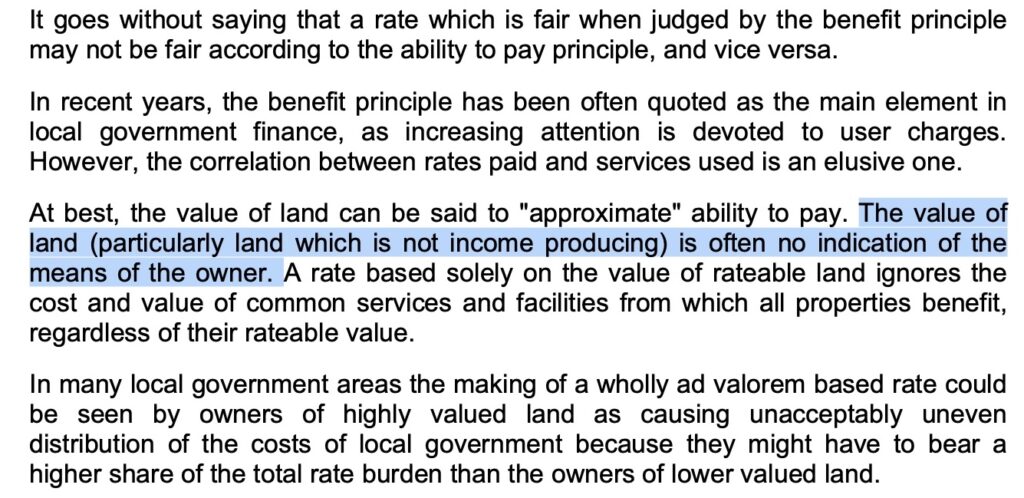
The new Council elected in December 2021 resolved in January to model changing the 'Base Rate' back to 50%. That's a move that I support. Those figures will be on public exhibition soon and the budget will be adopted to take effect July 1.
The common criticism is that people on acreage properties are rich and can easily afford higher residential rates, but the data reveals a different story.
The Hawkesbury Social Atlas displays a range of statistics about our area, including median weekly income broken down by suburb:
One analysis could be to compare median household income to median rates within the same suburbs to get a sense of fairness.

Weekly income and annual rates are figures with roughly the same magnitude (say $1000-$3000). It's not as though a ratio of one is a magic number – it's arbitrary, but it does allow for a comparison that factors in both rates and the 'ability to pay' principle.
Caveats: Such an analysis is just a guide – comparing the median-this to the median-that doesn't account for those that lay on the outer edges of those bell-curves. I know pensioners on below-median income sitting on land that just happens to be close to development that they loath and want no part of. Go and talk to them about what it's like to be taxed off the farmland that they and their parents grew up on.
Nor does this analysis touch on the other factor mentioned earlier – the relative access to services. Many residents of outlying suburbs live on dirt roads, and are far from the centralised services they are subsidising with their rates, while enduring other disadvantages. Setting rates with blunt tools isn't a science, as much as I wished were otherwise.
But this at least attempts to address the equity issue that is frequently raised by my colleagues in the chamber when they speak openly of 'rich acreage landowners' vs 'poor suburbanites' in built-up suburbs.
Here is what that comparison looks like for some suburbs under the current base rate of 30%:
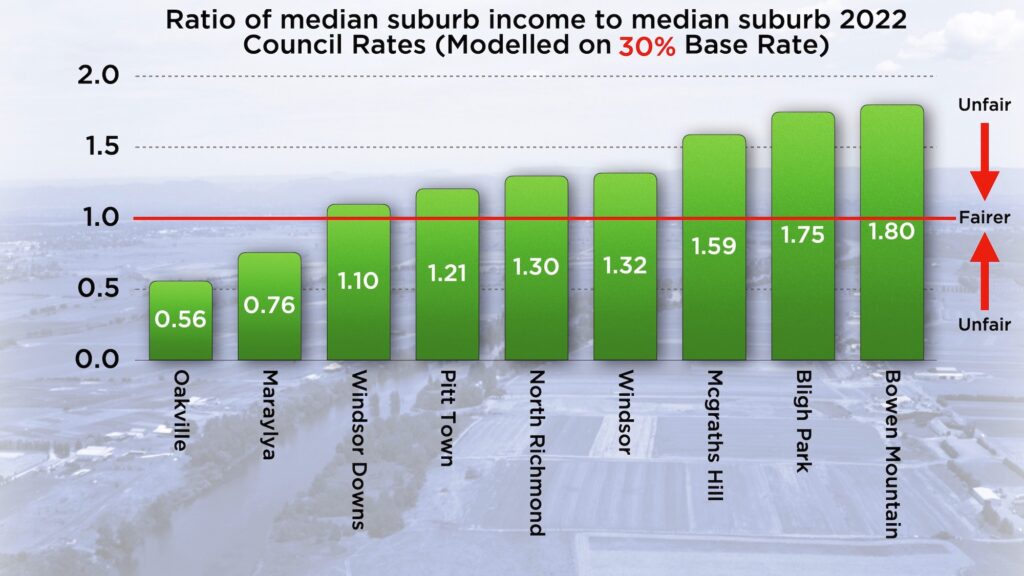
Here's what that means: Suburbs above a ratio of one are relatively advantaged, meaning that the rates they are charged are low compared to median household income in that suburb. Suburbs below the ratio of one are disadvantaged, meaning that rates are relatively expensive compared to income. In a fair system, one measure of fairness would be our ability to drive rates in suburbs towards the same ratio.
Now, here's what those ratios would look like for the same suburbs under a base rate of 50%:

Those suburbs who are paying not just double the average rates, but double even after factoring in relative income, move towards fairness. And other suburbs move in a modest way towards paying their fair share, and again, even after accounting for income.
If you want the raw figures, without adjustment for income, here is the preliminary modelling on a per-suburb basis for 2022-2023 rates in a range of Hawkesbury suburbs with a range of base-rates. These aren't final but will probably reflect figures which will be put on exhibition soon. Again, the base rate is 30% at the moment, and I'm advocating for it to move back to 50%.
A change to a 50% base rate is not a complete fix. It's cold comfort for residents in Oakville and Maraylya, enduring increased traffic from development and potholed roads being told that instead of paying well more than twice the rates as elsewhere, they'll now be paying only slightly more than twice even accounting for income.
Worse, the pensioner rebate on rates has been stuck at $250 for years and no longer keeps pace with our desire to give older people a hand, and Council has not addressed this in this year's budget. But any move towards fairness is a positive step.
Could we do more? Council can't set the base rate above 50% as that's limited by legislation. IPART released a long-delayed report into Council rating structures
Hawkesbury Council predicts it will take in $44M of rating income over 2022-2023 from 24,615 residences, 625 farms and 1617 businesses.
In 2016-17 that figure was $30.5M over 23,370 residences, 582 farms and 1509 businesses. In other words, Council revenue from rates have risen by 44% when the cumulative inflation rate over the same period was 11.6%
I’d say most Hawkesbury residents are prepared to pay rates that contribute to the common good, but their sense of a fair go is offended when they consider that some suburbs are paying two or three times the amount of rates of other suburbs with comparable income and access to services.
I'll continue to advocate for a fairer go while ever I remain on Council. If you don't already follow me on Facebook, Instagram or YouTube, please consider doing so for updates.
The Hawkesbury-Nepean River Floods - March 2022
July 2022 update. It's flooding again. Again.
I have been talking about flooding on the Hawkesbury-Nepean river for many many years. If you've arrived at this page as the result of a Google search, please consider these resources:
• My more recent video and post about the July 2022 floods, with some very striking video
• All my output on this website about flooding.
• My YouTube channel. This link should prioritise my videos about flooding. Please subscribe.
Original March 2022 post:
Flooding has again struck our community for the second time in 12 months.
This flood has risen to 13.7m (as measured at Windsor - which tends to be the benchmark), beating last year's flood of 12.9m making it approximately a 1-in-20 year event.
This video was taken when the waters still had about 2 more meters to rise.
I'm indebted to the excellent Hawkesbury Flood Statistics facebook page for making excellent real-time data available about river heights and closures.
Here's their summary after the waters subsided:

A New Accountability Measure - Report cards on Councillor Attendance and Expenses
May 2022 update.
I am disappointed to report that this reform, which I successfully passed in February, has since been rescinded by a rescission motion brought by the Labor and Liberal Councillors working together. Clearly they are disinterested in accountability of this sort, despite how warmly it was received by the community when I got it through before. They did not articulate any clear reasons why they felt there was new information that caused them to change their minds. Perhaps they realised that their attendance, expenses and whether they could demonstrate they got value from the conferences the Council pays to send them to made them feel uncomfortable. Further details of this reversal are here. I will continue the fight.
Original March 2022 post:
You're entitled to expect that your elected Councillors turn up to as many meetings as they can. It’s a critical part of our job.
Sadly, I've seen that this hasn’t always been the case. When the Hawkesbury Gazette sought figures on Councillor attendance in 2019, it found fragmented data. I was acknowledged as having among the best attendance records of any Councillor.
I resolved to do what I could to improve accountability.
Legally, Councillors can only be censured if they miss multiple formal Chamber meetings, but in my opinion that accounts for only about a third of what Councillors do. Data is either not collected, or not summarised relating to attendance at briefings, workshops, committee meetings and community consultation sessions.
Condolence Motion for Dick Petrikas of Tennyson RFS
We lost one of the Hawkesbury Community's greats recently with the passing of Dick Petrikas from Tennyson, at the age of 83.
Dick ran his business on Tennyson Road selling all manner of farm equipment for over 50 years. He spent 43 years as Captain of the Tennyson RFS from 1976 to 2001 and further 14 years as Deputy until semi-retirement in 2015.
Dick, his mother and sisters fled their ancestral home in Lithuania towards the end of WW2.
Travelling by rowboat, they were intercepted by fisherman and ended up interned in a migrant camp that was eventually liberated by the British.
The family decision to emigrate to Australia instead of Britain was apparently sealed by the impression the family gained of Australia from watching Chips Rafferty movies.
They arrived at the Migrant Hostel in what is now Scheyville National Park, just up the road from where I live, in 1948 and the rest is history.
Dick and his family have been fixtures in the Hawkesbury Community ever since. Dick’s business traded with Colo Shire Council and Hawkesbury Shire Council.
He was awarded the National Medal in 1993 and had since added two clasps for his extraordinarily long service.
Dick could be proud that his whole family went on to become contributors to the Hawkesbury community in their own right in the RFS, SES and elsewhere.
I acknowledge Dick’s wife Julia, and their children Chris, David, Merien, Greg and Steve.
I enjoyed speaking with Chris, who is himself decorated with the Australian Fire Service Medal to put together these notes.
Dick left behind 11 grandchildren, 8 great grand-children and more are on the way.
We’ve lost too many of our local greats recently, with the passing of Aub Voller, then Albert Newton, Peter Speet, Lionel Smith and now Dick Petrikas.
I invited my fellow Councillors to join me in a moment’s silence to mark Dick’s passing.
This video also shows the remarks made by my colleagues Councillor Les Sheather and Councillor Mary Lyons-Buckett.
Celebrating 70 years of Her Majesty's reign
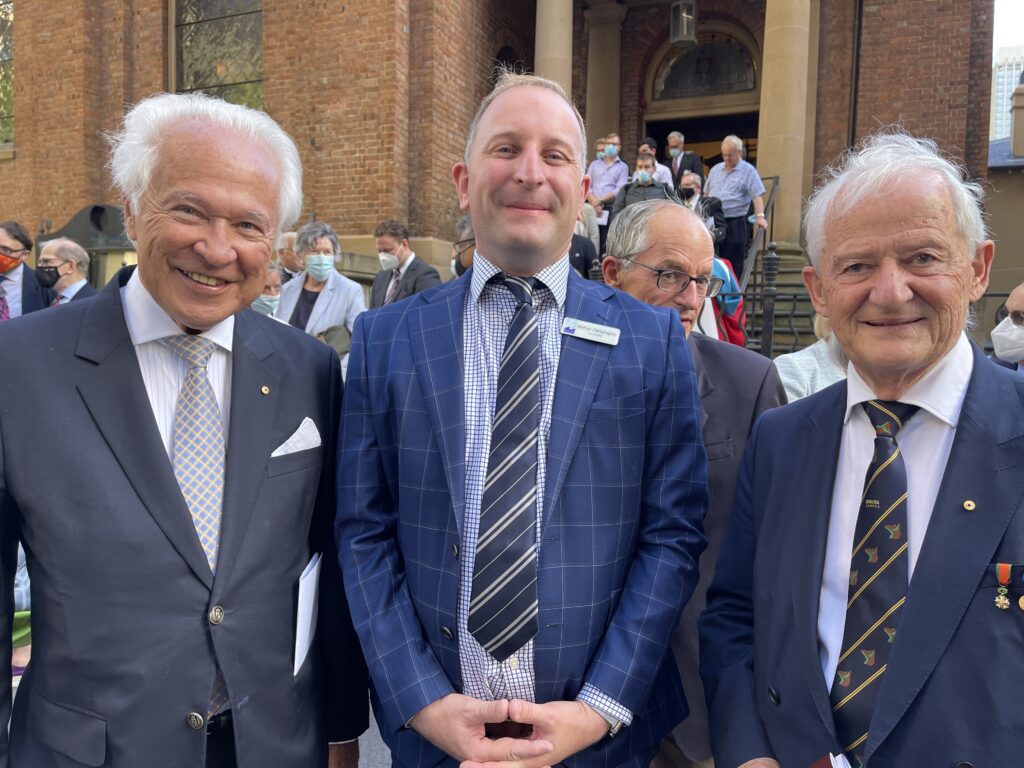
I was honoured today to be invited to the official service to commemorate the 70th anniversary of the Accession of Her Majesty the Queen, with Her Excellency the Honourable Margaret Beazley AC QC, Governor of New South Wales and other dignitaries, held at St James' Church in Sydney.
What an absolutely extraordinary life our Queen has had. She has reigned over the life of both our nation and the wider Commonwealth with grace and wisdom. She has been served by fifteen Australian Prime-Ministers (and coincidently, fifteen British ones).
I support the Monarchy because at its best it represents selflessness in service to others, and the modelling of ideals that rise above the rude acquisition and preservation of political power. I also laud the Royal Family’s patronage of over 3000 organisations pursuing voluntary service, or charities, or good architecture, or the Arts, or environmentalism (in some cases, years before such causes became mainstream).
The miracle of our Constitutional arrangements is that the Monarch, custodian of all those powers which are often used to oppress people elsewhere who suffer under authoritarian regimes, are guarded by a figure who by custom and precedent will never use them.
The idea that a government can only govern so long as it has the support of the people? The principle that all people and institutions are subject to and accountable to laws? The idea that the justice system should treat everyone fairly and equally? These are principles that are safeguarded by the Crown. That’s the reason why when you walk into a Court you see the Royal Coat of Arms rather than a State crest. The Crown upholds our rights.
I feel suspicion when people seek to replace the system that has given us peaceful and democratic government for centuries on a whim, or in the service of empty symbolism, or to politicise a realm that is refreshingly absent from it. Australians have and will continue to reject that.
But I am hopeful that all people, Republicans and Monarchists alike, can unite today and celebrate Queen Elizabeth for what has unquestionably been long life given in service to others.
I’m pictured here with the Hon. Philip Ruddock AO and Professor David Flint. Thanks to the Speaker of the New South Wales Legislative Assembly The Hon. Jonathan O'Dea for taking the photo!
Long live the Queen!
On ABC Breakfast Radio about Warragamba Dam (again)
Hawkesbury Council rejects critical flood safety measure – Again!
Our community has known we have to 'Live with the River' since the time of settlement. Our relationship with the river and the inevitability of floods mean we're forever torn between the blessings of rich soils and the river's deadlier moods. My own ancestor was killed in Windsor in the flood of 1809.
But human ingenuity has given us the ability to dam rivers, and we're now told that raising Warragamba Dam by 14 meters will reduce the frequency and severity of flooding here by 75%. That it would reduce the number of homes flooded by 5000. That the damage bill would reduce by $3,000,000,000. We need that. If only we had it in March – it would have spared 500 homes and reduced the flood height by 3.5m.
The new EIS is open for public comment until the end of November. Here are all the EIS documents, and I strongly suggest you start with the Executive Summary, given that the whole EIS is 8092 pages long. Council would be completely negligent on behalf of our community, who endure the highest risk of flooding in Australia, if we didn't make a submission. Submissions run until the end of November. You should consider making a submission (look for the link in the top right corner)
I'm appalled that a majority of Councillors are so wedded to their ideology that, at last night's meeting, they voted even that down. The video above summarises what happened at the meeting.
That's right - they voted down even putting forward our own community's concerns in a document to the State Government.
I know not everyone agrees on this issue, but this is reckless and treats the 600 families whose homes were flooded out in March with contempt.
And yes, this absolutely should be an election issue.
I have of course been very, very active on the subject of flooding over this five-year term of Council: Here's a list of all my videos and motions before Council on this subject.
How much land clearing should people be able to do for fire safety? The Rural Boundary Clearing Code
The Rural Boundary Clearing Code
The commentary here is in reverse chronological order. If you're interested, I suggest watching the videos in the order shown here.
February 2022 third go-around, and things get worse.
The "Rural Boundary Clearing Code". It came to Council for the third time last night.
Why is this so contentious? It might strike you as an obscure decision about land-management policy. But it disguises a far more important principle, and it's very much at stake in this new Council, so it's important to know what this is about.
Some people feel the massive bushfires we endured demonstrate we should allow people more freedom to clear their land for fire safety. Some people worry (and we were shown proofs) that this threatens habitats and that fire safety will be used as an excuse for some to just clear their land for other reasons. Others worry that the Code just won't do what its authors intended because of our local conditions.
All of these concerns are valid.
Passionate, honourable disagreements are why we sit as a Council of twelve to work through these issues. The solution is to consult the community and experts in the field, get informed, and then make considered decisions. Almost every policy Council adopts follows this process.
But not, apparently, this one.
This has been rammed through without any consideration or consultation – and especially with the RFS, who reminded us tonight of their own well-developed plan to improve fire safety. They're white-hot about the disrespect this lack of consultation represents. And that's why I've differed in my opinion with my Liberal colleagues, with whom I usually agree on other issues.
The issue is why we would adopt a policy with such far-reaching consequences for our land management – which has enormous implications for endangered species like Koalas, and on which opinions differ sharply concerning whether it will actually improve fire safety at all – without any consultation with the local RFS. And no resourcing of Council to do compliance and mitigate against mis-use of the Code. And without any thought of how Council should help landowners navigate their eligibility and be good stewards of their land. And without the ability to even measure the impact on tree-cover across the LGA when that could easily be remedied with new off-the-shelf mapping tools.
Frankly, it makes the rhetoric of people who frequently say they respect the RFS, and like to make much of saying they support Koala habitats, more than a little hollow. Worse, in the meeting tonight, debate was axed which cut off Councillors who were yet to speak to the chamber, despite having their 'zoom hand' up for half an hour. That was wrong. When we disagree, we shouldn't silence people just because you may not like what they might say. It's no way to run a respectful chamber, and I disassociate myself from those who use it as a tactic.
Look, ultimately it may be best if we adopt the Code. But we can't know because we haven't asked the right questions. And that's our job, so I don't apologise for speaking out.
The above video represents my remarks, but the full video of the Council debate is something I recommend you watch.
January 2022 - The new Council reverses its previous position and rams the Code through
Last October some of my colleagues tried to ram through the adoption of the "Rural Boundary Clearing Code", which would allow the clear-felling of up to 15,800 hectares of rural land where landowners assert such clearing is needed to improve fire safety.
I think that Council has a moral obligation to look at this area, given the loss of 65 homes in the Hawkesbury in the fires.
But balancing community safety with protection of the environment is challenging. It takes leadership, and nuancing the various issues and views, not ramming something through without consideration of the consequences.
That attempt last year failed.
Firstly, we had conducted zero formal consultation with our local RFS.
Secondly, it was clear that we needed to resource Council to measure the effects of this policy with geospatial mapping tools, provide guidance to landowners about the torturous eligibility criteria, and ensure we could conduct basic compliance and enforcement. We had no knowledge of a single other Council taking up the voluntary adoption of this code and what that experience looked like for them, and many local experts told me that they were either opposed, or took a "yes, but" approach contingent on these basic precautions.
I advanced an alternative motion to get Council to conduct that consultation and resourcing, and I got it passed. The report would have come back to Council this year.
However, the complexion of the Council chamber has changed, and on Tuesday my Liberal colleagues again tried to ram summary adoption of the code through. This time, they had the numbers.
So that's it. No consultation. No resourcing for partnering with landowners. No resources for mapping, compliance or enforcement.
Oh, and no takebacks. Once we're in, we're in for good.
I think of this as a massive slap in the face for our local RFS, who are free to be for or against this, but who would have at least been accorded the courtesy of being *asked*. So much for the oft-claimed respect for our RFS.
I've always claimed that it's possible to be a good Conservative, and a good Conservationist. It's a pity that this looks nothing like that.
Environmentally conscious voters in the Hawkesbury, and if I might suggest, across the seat of Macquarie ought to keep their own counsel about whether this looks like the kind of representation they want
In favour of the summary adoption of the code was:
Mayor Conolly, Clr. Richards, Clr. Reardon, Clr. Veigel, Clr. Sheather, Clr. Dogramaci. Passage was ensured with the casting vote of the Mayor after a 6-all deadlock.
Original October 2021 commentary:
At last night's Hawkesbury City Council meeting we considered a thorny question: How much should landowners be allowed to clear their land to protect themselves from bushfires?
Granny Flats: You deserve more choice | Hawkesbury City Council
I want to talk about granny flats and dual occupancies, because the way that Hawkesbury Council currently treats them is insane.
A dual occupancy is just a fancy way of saying there are two houses on the same block of land, but under one title, one owner.
It’s not like a subdivision because there’s no rezoning, no sale, or separation of the ownership of the land.
There are two kinds of dual occupancies: Detached, where there’s two, separated full-size houses on the same block, and attached where two dwellings are connected in some way, like a Duplex.

I live in an attached dual occupancy here at Oakville with my family, where we have two houses which are connected by a covered walkway.
And here’s the crazy thing: At Hawkesbury Council, detached dual occupancies are forbidden because of, wait for it, flood evacuation risks. And that's regardless of whether you’re in Bilpin or Oakville, well out of harms way of a flood. But put that covered walkway in, and everything’s peachy. Totally fine. Permitted.
Detached dual occupancies are already permitted (with constraints) in many other Councils, like Penrith, Hills, Cumberland, Parramatta, Northern Beaches.
But it gets worse: People often get confused between Dual Occupancies and “secondary dwellings”.
Secondary dwellings are much smaller, only up to 60 square meters- which is little more than 1 or 2 rooms, and must be close to the primary dwelling. We call them “Granny flats”.

Now if you want to build a granny flat in, say Bligh Park, or Hobartville, in any of these residential zonings, on a block that’s under 800 square meters, apparently that’s fine.
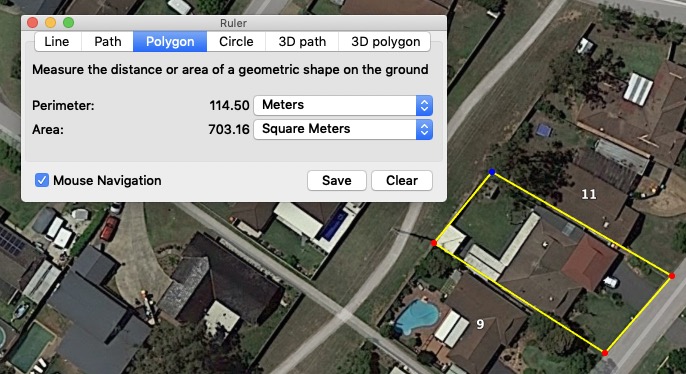
But if you live in one of these zonings in a rural area, like a five acre block, 25 times the size of a house block in Bligh Park, the answer is no. You can’t. It’s not allowed.

This makes no sense at all.
During this this term of Council I have been the strongest advocate for reform of these rules, but I’ve been stymied by a lack of support among the other Councillors.
I’m seeking your support to continue this work through your vote in the upcoming election.
Let me explain why this is important:
For a balanced community, the Hawkesbury needs a mix of housing types. I’ve argued that dual occupancies confer a range of social benefits.
Your ability to put another dwelling on the land that you own could allow you as parents to give a leg-up to your kids to build a home, or get equity in the market, or to continue to live in the communities that they grew up in, or to enable grandparents to care for their grandkids.
On the flipside, it might allow you to look after your parents in their senior years with a degree of independence, but still close to those they love, sharing the burdens of property maintenance or the costs of living.
The way that my family lives exemplifies this: I live in a multigenerational household, with toddlers, teens, adults, seniors, spaniels and cats living together in a joyous chaos.
This 2020 article from the Sydney Morning Herald on multigenerational households really resonated with me.
I’ve heard this described as a very European way of living. It’s not for everyone, but for many families it makes a lot of sense. For some, it’s an economic necessity.
But ultimately it’s about choice. Your choice.
Studies show that one in five households are multi-generational, and that figure is growing (Source: City Futures Research Centre, UNSW Dept of Built Environment). And 40% of people in their twenties are still living at home (Source: Australian Institute for Family Studies).
To me, it’s an example of how something obscure – good planning laws, can strengthen our communities by empowering Council to plan for diversified housing choices with far less impact on existing services and infrastructure than full blown subdivision.
Others support secondary dwellings because it represents a form of affordable housing, which we badly need more of.
Lastly, we can’t ignore the fact that many acreage areas are and will continue to be subjected to development pressure. I. am.no.fan.of.overdevelopment.
But dual occupancies may represent a kind of happy compromise between the status quo, and the wholesale rezoning and carve-up that developers want to inflict on us.
Many people I speak to want a sensible solution like this, but I challenge you to find another Councillor that can point to a public statement they’ve made in support of it.
And you and I probably know someone in the area with a clandestine granny flat that’s offending nobody but against the rules.
In February this year, Hills Shire Council next door took advantage of a change in State rules, something called the ‘LEP Standard Instrument’ to apply for, and get, a more generous definition of Granny flats.
As a result, Hills landowners can now build granny flats that are still modest, but larger than before: whichever is the larger of 110 square meters or 20% the size of the main dwelling, up from 60 square meters.
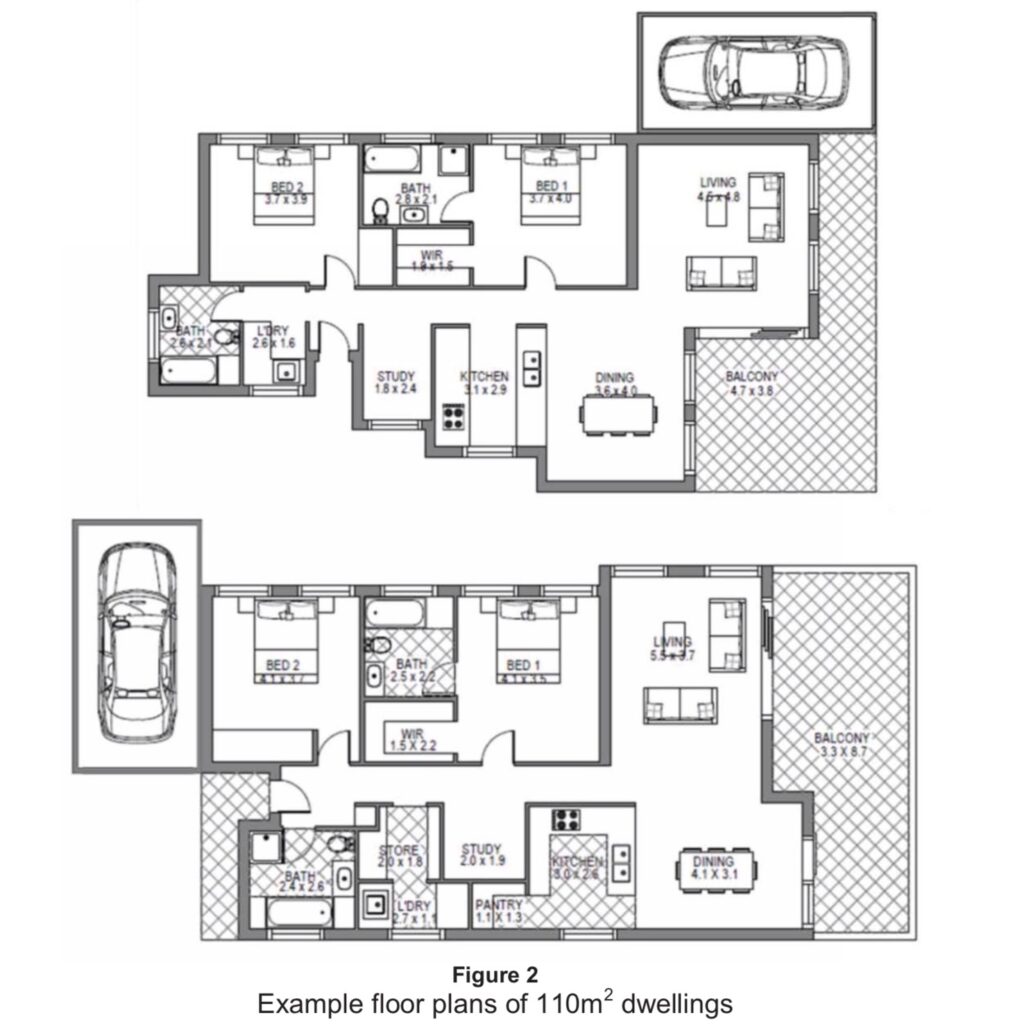
I’d like Council consult and consider doing the same, using a place-based approach that’s sensitive to all the factors and constraints, like land fragmentation, loss of agricultural capacity, emergency evacuation, local roads & infrastructure and the protection of the environment.
As I said, I’ve tried to drive reform in this area and so far I’ve failed.
Our best hope is the detailed work Council has done this year in revamping our LEP and DCP – our two fundamental planning codes, but progress has been been painful and slow.
I’ve pushed for these proposals to be put into the new codes for public comment, but it’s the next Council that will sign them off.
I’d love to hear your views. What do you think?
Hawkesbury Council's position concerning the new Hawkesbury River bridge
Last night Council considered the submission we would make to the consultation process on the route of the new Hawkesbury River crossing at North Richmond.
My position is guided by an awareness that this is not Council’s project. Like the Windsor Bridge project before, we neither decide nor craft its appearance, budget or timeline.
However, Council does have a role to listen to residents and then represent their concerns clearly. And other tiers of government, if they are wise, should listen. I’ve been contacted by dozens of residents and had long conversations both for and against the preferred ‘green route’.
I’m persuaded that the briefings conducted by Transport for NSW make a good case for the preferred ‘green route’. The modelling clearly shows it saves the greatest amount of travel time, is subject to fewer ‘major’ constraints, has a superior cost-benefit ratio compared to the purple route, will draw more traffic away from the already-congested current crossing, and will have a lower impact on the landscape in terms of earthworks, heritage and ecology.
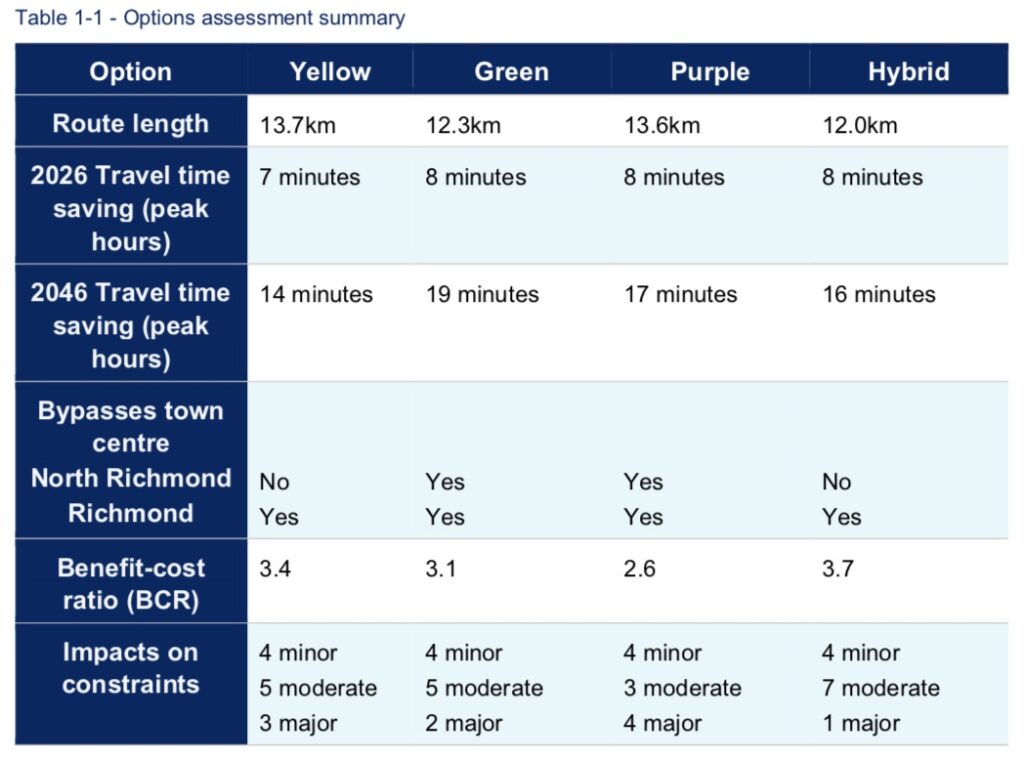
That said, there are still substantial unanswered questions before us, and many ways in which the proposed route could be improved. If we don’t ‘hustle’, the community won’t get what we deserve.
I remain concerned about the impacts on the residents of Hobartville, and especially on Southee Road and Inalls Lane.
I think the intersection of Kurrajong Road, Old Kurrajong Road and Yarramundi Lane should be an elevated flyover – not just to reduce traffic congestion, but to provide better flood resilience as well.
I’m happy for Council to acknowledge the strengths of the green route, but continue to press for investigations to continue into a hybrid green/yellow route – especially if that benefits the users of the playing fields on Yarramundi Lane.

Lastly, the community needs to know whether the status of the Grose River crossing – contractually bound on the Redbank developers, but much delayed and still no certainty, affects the modelling.
I am pleased that Councillors understood the need for a bipartisan approach on this, and with the exception of Councillor Ross (who votes against everything in what I regard as a very unconsidered attitude), we will be making something close to this submission.
Make no mistake - raising Warragamba Dam will make our community safer


When will the NSW Local Government Elections be?
https://youtu.be/o2ELM-_ZGP4
Participants should be aware of new arrangements that have been made for posters and electoral material distributed during the COVID-19 pandemic, contained in recent changes to the Local Government election legislation.
To comply with public health orders at the time of the elections, or to reduce the risk of COVID-19 infection, the Electoral Commissioner may direct that no posters are to be displayed and that noelectoral material is to be handed out to voters for the December 4 elections at:
- a polling place or a pre-polling venue, or
- premises occupied, used by, or under the control of the NSW Electoral Commission, other NSW government agencies or a council within 100 metres of a polling place or a pre-polling venue.
Premises include buildings of any description, other structures and land (such as the street).
Given the evolving Delta strain outbreak, candidates and parties should be prepared that directions limiting posters and how-to-votes may be made by the Electoral Commissioner across NSW.
The Tragedy of Afghanistan

I rarely venture into geopolitics, but what’s unfolding in Afghanistan now is a tragedy. The Taliban are resurgent, and will shortly repossess all the territory won from them after 2001. So much of our own blood and coin spilled for no gain after a twenty year war.
How must the 26,000 men and women of our own defence forces who served there think. Or the families of the 41 soliders who died. Or the many more wounded or traumatised.
And we've let down the innocent of Afghanistan - the interpreters and guides who assisted our troops, and for the children and women who are now living in fear.
Ultimately, I believe our presence in Afghanistan was just. I don't believe that any accusation of aberration from our values invalidated the rectitude of our overall mission. We were there to uphold human rights, not to abuse them. I don’t agree with the complaint that the West had no business being there. The Taliban are brutes. They banned schools, music and even kite-flying in the service of their murderous creed, even as they institutionalised child rape and a hateful, fundamentalist, medieval social order.
Under the Taliban's twisted Sharia, a woman can be publicly flogged merely for appearing on their balcony, or for wearing embroidery on their sleeve, or for drawing water from the wrong well; a man, for trimming his beard, or owning a phone.
I ask: what does cynicism gain us? If one nation can do anything to bring the rule of law, adherence to international norms, or human dignity to another, surely we should try? Imagine if Australia had taken the view that the struggle against Nazism in Europe was too distant or irrelevant for us to bother with. Opposing evil is a generational moral duty.
Worse, the West's withdrawal makes the world a more dangerous place. Afghanistan will again become an incubator for Islamic fundamentalism. The bitter fruit of that may lay years in our future. The next Osama Bin Laden sleeps safer now than he did last year.
I think of Nobel Peace Prise winner Malala Yousafzai, raised in the Afghan borderlands. She was shot on a bus for daring merely to attend school. I weep when I think that there are a million Malala’s in Afghanistan and north-west Pakistan whose voices will now be brutally silenced.
The fact that the war became intractable did not mean that the cause was not just. I think too much commentary fails to make that distinction.
It’s not that I don’t accept the finality or necessity of our withdrawal – we couldn’t stay in an open-ended engagement forever. Just that our failure should grieve us all. Our failure to maintain the political will to get the job done. Our failure to the people of Afghanistan.
I'm reminded of Thomas Friedman's argument in The Lexus and the Olive Tree that likens nations to computers. You can't boot "DosCapital 6.0" as he put it (modern democratic institutions, independent judiciary, universal franchise, free press) on medieval hardware (a social system based on tribalism and superstition). This explains why Germany and Japan in defeat after WW2 became model international citizens, and Afghanistan, after 20 years and $2 trillion of war and nation building, has not.
Being a reader of history also reminds me that this intractability was foretold a century before the West, or the Soviets got mired there.
A Young Winston Churchill didn’t hold back when he served in Afghanistan in the Malakand campaign in 1897. In the same deployment that had him famously quip “Nothing in life is so exhilarating as to be shot at without result”, he also formed a pointed view of the complexities of the region. He wrote a famous, and lengthy account:
“...Every tribesman has a blood feud with his neighbor. Every man's hand is against the other, and all against the stranger… the weapons of the nineteenth century in the hands of savages of the Stone Age.”
“Every influence, every motive, that provokes the spirit of murder among men, impels these mountaineers to deeds of treachery and violence... That religion, which above all others was founded and propagated by the sword—the tenets and principles of which are instinct with incentives to slaughter and which in three continents has produced fighting breeds of men—stimulates a wild and merciless fanaticism.”
“The love of plunder, always a characteristic of hill tribes, is fostered by the spectacle of opulence and luxury which, to their eyes, the cities and plains of the south display.”
“And all are held in the grip of miserable superstition, which exposes them to the rapacity and tyranny of a numerous priesthood— the Mullahs, who live free at the expense of the people. More than this, they enjoy a sort of ‘droit du seigneur’ [right to rape a woman on their wedding night] and no man's wife or daughter is safe from them. Of some of their manners and morals it is impossible to write.”
Like most people fortunate to be born into an age of peace, I am appalled by war, and repulsed by those who glorify it.
But if the might of our armies cannot be employed to lift the faces of people so downtrodden, then what is all our power for?

People are hard on the idea of “Empire” these days. But I remember what Lord Curzon, Governor General and viceroy of India said when he was asked what the noblesse oblige of the West was. He said in a 1905 speech:
“To fight for the right, to abhor the imperfect, the unjust or the mean, to swerve neither to the right nor to the left, to care nothing for flattery or applause or odium or abuse… but to remember that the Almighty has placed your hand on the greatest of his ploughs… to drive the blade a little forward in your time, and to feel that somewhere among these millions you have left a little justice or happiness or prosperity, a sense of manliness or moral dignity, a spring of patriotism, a dawn of intellectual enlightenment, or a stirring of duty, where it did not before exist. That is enough. That is the Englishman’s justification.”
Both we, and the people of Afghanistan will suffer the consequences of our failure to eliminate the Taliban.
Further delays to the Grose River Bridge should make you cranky
https://youtu.be/FuF-kUkjoSY
The Redbank project, and associated wrangling over the promised Grose River Bridge crossing goes all the way back to 2008.
So if you're angry or confused about why it seems that this infrastructure keeps receding to the horizon, then I'm with you.
Why is it taking so long? And why, after this week’s Council meeting, is it going to be delayed even more?
Here's what you need to know. This video lays out the timeline of this issue.
I have been on about this issue for this entire term of Council.
From 2016:
https://councillorzamprogno.info/2016/10/15/about-the-redbank-development-at-north-richmond/
And 2017:
https://councillorzamprogno.info/2017/04/10/about-the-grose-river-bridge-and-the-redbank-development/
Why you should be angry about reckless election-season posturing
If there was any doubt that the election silly-season is upon us, this week's Council meeting should leave you in no doubt.
Two things in particular stand out – variations on the same theme, one might say.
Two motions came to Council, calling for us to abandon our relationship in two regional bodies, WSROC and HRCC - one of which we have been a member of for 73 years. I regard this as lazy, reckless vandalism parading under the patina of 'reform'.
This subject matter may feel obscure, but it's really important to understand. Here's the shortest explanation I can give you:
The Problem
In the scheme of things, Hawkesbury is a small-ish Council. Huge in area, yes, but our revenue base is only one-third of that of our neighbours, like Penrith and Hills, and less than a fifth the size of Blacktown (source data). That means that there are times where it's better to band together with others to achieve good outcomes for our community.
Sometimes we do that to save money. Shared-service models are a proven way to achieve economies of scale in procurement, insurance or service delivery. In other words, bigger is better.
Sometimes, it's because there are some issues that don't stop at Council's borders, and good sense requires a regional approach, like ensuring the health of the Hawkesbury-Nepean river.
And sometimes, we do it to stand with other local governments and speak with a common voice. When bullies (usually other tiers of government) shift cost burdens to ratepayers, overlook the concerns particular to western Sydney, or issues are more appropriate for local governments to take the lead, then it's good to have friends.
All these reasons, among others, were why our Council has long maintained membership of HRCC and WSROC.
WSROC, the Western Sydney Organisation of Councils was created in 1973 and Hawkesbury may be a founding member. If so, we've remained associated with it for 48 years because it has been strongly in our interests to do so. Councils come and go over the years based on shifting assessment of value, just like it's always been an evolving patchwork quilt of political views. But for Hawkesbury, it remains a valuable relationship for us because of our size. Our former Labor Mayor, Councillor Barry Calvert is the President of WSROC, and I am our Council's other delegate and Director, so I'd say we represent non-partisan representation. The positions are unremunerated.
Similarly HRCC, the Hawkesbury River County Council was founded in 1948 and looks after weed control and waterway health across a four Council area including Hawkesbury, Penrith, Blacktown and Hills. It's one of those bodies most people have heard of but know little about, despite the fact it serves over 830,000 western Sydney residents. It's a fully constituted Council in its own right and governed by the same legislation as other larger Councils. It just overlaps the jurisdiction of municipal Councils and has a particular focus – these days governed by the Biosecurity Act. I have been a member of the HRCC Board since 2016 and Chairman since 2019.
Hawkesbury River County Council
What HRCC does is an unalloyed good. In 2004 the Hawkesbury Nepean River was hopelessly choked with weeds. New resources allowed HRCC to clear it and another outbreak of that scale has never happened since. Recently, we kept the river clear of weeds so that our Olympic rowing team could train on the river at their facility at Penrith - and Rowing Australia have been strident in expressing concern and support for us while we've been wrangling with the State Government who have cut our operational funding for weed activities on the river. I've taken that the fight directly to the Federal Assistant Environment Minister, Trevor Evans.
There's so much good that HRCC and its staff do: It has been in the vanguard to sponsor bush regeneration schemes, like the Blue Mountains Shale Cap Forest Project I launched at Bilpin last year. I've raised awareness of its Landcare and creek health initiatives for years. Here's a lovely example of an Echidna spotted by HRCC staff working near the Friendship Bridge over Bardanarang Creek at Pitt Town, a location I've helped clean up myself, and hopefully evidence of improving ecological health.
However, at this week's Council meeting, Labor Councillor Amanda Kotlash brought a motion to Council which proposed, in part to "ask the Minister to dissolve HRCC as a County Council but keep its structure and function and annex it to one of the constituent councils."

I think that's an absolutely irresponsible proposition, and profoundly counter to our interests. Here are the facts:
Hawkesbury Council contributes ~$200,000p.a. for membership of HRCC - about 0.2% of our income. The four Councils contribute equally despite the fact that the Hawkesbury comprises 73% of the area covered. The County Council is headquartered in the Hawkesbury (in Walker St at South Windsor). Arguably we get the lion's share of benefit from this arrangement, to which the four member Councils are bound by legislation.
These membership dues make up roughly half of the HRCC's income, the rest coming from grants and funded programs. A report we received in April stated that works undertaken in the Hawkesbury LGA in the F.Y were valued at $471,510. Further, if we were to "go solo" and become our own "Local Control Authority" it would cost Hawkesbury over $610,000p.a. to get the same results, given that HRCC has significant economies of scale, unique plant and equipment, and access to grant funding.
In short: We get massive value, hugely in excess of our membership fee, for this long-standing relationship. It works, and it works well.
HRCC's successful model for service delivery has been confirmed and reaffirmed over and over: By a NSW Independent Local Government Review in 2013, by a NSW Weeds Review in 2014, in part by the 2015-2017 "Fit for the Future" process, and now through our own Council's assessment of the costs of exiting the partnership.
Dissolving the HRCC and gifting it to one of the member Councils (she doesn't suggest which), would break the very co-operative model that has grown up between the four Councils over many decades. I can attest that the Board I lead is, with this exception, ecumenical, friendly, and supportive. The proposition to dissolve HRCC has, at time of writing, zero support from the other member Councils.
I labelled the motion reckless because the debate simply sailed straight past these facts - even the report commissioned specifically from our own staff that showed this partnership delivers outstanding value. Not a word was said that attempted to negate or contextualise that data as so wrong that breaking up HRCC after 73 years is the best option.
I'm not shy about questioning long-standing arrangements, and I have been very critical in this term of Council to ensure everything we do has an adequate justification and delivers value. There are no sacred cows for me. Why is my favourite question. HRCC wrestles with an increased regulatory and reporting burden, and like any organisation, balances the tension between admin overheads and front-line staff. But the motion suggesting that dissolving HRCC will release 'wasted' overheads for other uses is just not true.
This motion was, in my opinion, lazy and misguided. However, the motion passed. It is unlikely to result in the dissolution of HRCC given the zero buy-in of the other Councils and the legislative hurdles to unravelling. For those interested in such things, the other Liberal Councillors voted against me.
WSROC - The Western Sydney Regional Organisation of Councils
Five years ago, Council commissioned a report about whether Hawkesbury should remain as a member of WSROC. Frankly, that boggles me. Five years. Why this report has taken this long arrive was not explained.
Whatever the reason, the report laid out the case very well. WSROC membership costs Hawkesbury $92,000p.a, or 0.08% of our total income. Membership has allowed us to access annual joint procurement savings which exceeded $2.9M across the member Councils.
Hawkesbury specifically saved $87,000 over two consecutive years through one initiative alone - the Western Sydney Energy Program (a program that saved Councils a cumulative $15.8M over its lifetime and saved the emissions of 380,000 tonnes of CO2), and we saved a cumulative $145,196 through participation in the Light Years Ahead street lighting scheme.
Meaning, our membership easily pays for itself, to say nothing of the ability for Hawkesbury to punch above its weight as part of a larger voice for western Sydney.
WSROC has pioneered a number of initiatives involving urban heat, reducing the waste going to landfill and into waterways, hosted 48 forums on regional co-operation, met with Ministers over a dozen times to represent regional concerns, secured $413,000 of funding beyond membership dues to deliver on strategic priorities, and led conversations with government over sustainability and resilience, including with Resilience NSW Commissioner, Shane Fitzsimmons.

Given these focus areas, I am baffled that the Greens and left-leaning independents would vote against ongoing WSROC membership. There is simply no better vehicle for our Council to pursue issues like urban heat, climate change, energy efficiency, resilience, sustainability, and waste than WSROC. But they were happy to throw it all away to score a political point.
Despite the findings of the report, Councillor Emma-Jane Garrow brought a motion to discontinue our membership in WSROC, effective immediately.
Clr Garrow never approached myself or Councillor Calvert to ask us if we felt our membership still represented value. She's never attended a WSROC meeting. She didn't address a single word to the report that Council staff wrote to cast doubt on its statistics laying out the cost-benefit of our membership. Vague sentiments were offered about our Council being able to participate in some of WSROC's initiatives in an ad-hoc fashion as non-members, but this was not backed with any data as to which, how, or why this would be a better option for us. Clr Peter Reynolds said that WSROC has an "East-West" focus when what we need is a "North-South" focus, when that's precisely what WSROC have been pivoting to, especially in relation to the airport rail link.
Those who supported Clr Garrow's motion offered ill-informed opinions, but no facts. Thankfully the motion was defeated, with a replacement motion tasking Council to write to WSROC to ask them to re-iterate the financial and other benefits of our ongoing membership.
Those who voted to withdraw from WSROC were Clrs Garrow, Rasmussen, Lyons-Buckett, Wheeler, & Reynolds. Supporting retention were myself, and Clrs Conolly, Calvert, Richards, Kotlash, Tree and Ross.
Lazy, reckless, ill-informed decision making
I am sick of Council meetings where Councillors make decisions based on whims and personal antipathies rather than hard data. Sometimes, it's obvious they haven't read (or don't like) the data that Council staff include in the reports that come to Council. Just like I'm sick of Council staff holding workshops and briefings on key issues and finding I'm one of only 3 or 4 Councillors that turn up. This week we held the latest of eight different workshops for us to examine the decade-overdue revamp of our planning instruments (our DCP and LEP). It's a massive job, and the most consequential thing I'll do in this term of Council. I've attended all of them. Most, including this week's workshop had four Councillors in attendance for the bulk of that time. Not good enough.
In my view, this twice-delayed election can't come too quickly.
The audio of the debate that encompasses the two motions I discuss are at Council's SoundCloud account. The Business paper for the Council meeting is here.
A Win For Colbee Park Users – A Masterplan... And $573K in Funding!

Overwhelmingly, the biggest problem Council has with developing masterplans for our parks is there is no money allocated to execute the plans once they're made. In this term I have lamented that community consultation and masterplanning processes raise community expectations, only to dash them with no follow-through.
Take Colbee Park in McGraths Hill as an example. It is one of our most used, and most neglected sports fields. I should know, as a Soccer Dad whose child’s club was based at the park for a decade.
I've been engaged in a long campaign of engagement and advocacy to get some funding for improvements to the park.
The process for developing a Masterplan for the park has taken two years. Community consultation began in August 2019, and received a surprisingly strong response, with 152 online survey responses.
In September 2020, Council exhibited a Draft Masterplan, and I engaged with various stakeholder groups such as the Oakville United Soccer Club, the Oakville Raiders Baseball Club, and the Hawkesbury Hornets BMX Club to ask if the plan met their current and future needs. The response was mixed, with feedback mentioning limited vehicular access to the BMX track, a lack of lighting (making Colbee the only competitive BMX track in Sydney without lights), noting the susceptibility of the park to low-level flooding, and suggesting storage be moved to higher ground.
Crucially, and as was observed by the media at the time (in September 2020), no money was in prospect to build the improvements to the park.
Hopefully, this will change now. I moved for Council to adopt the new masterplan for Colbee Park at our meeting tonight. It was passed unanimously, and after my advocacy last year, I'm pleased to say that $573,000 has been allocated in the 2021-2022 Budget. This is not enough to complete all the improvements, but it's an excellent start. These funds will allow core or 'enabling works' that facilitate future improvements, and will benefit the whole park (not just any one user-group).
I am convinced that only by having a local Councillor continue to advocate for future budgetary commitments, will this program continue to advance. I didn't hear any other Councillor advocating for Colbee Park. No other Councillor lives in the area. I do.
Many of the earlier issues raised by stakeholders have been addressed, and I've contacted each of them to verify they are satisfied with the final plan.
The masterplan documents are available at Council's website (meeting of 27 July 2021, item 140).


We should look after Jenolan Caves better
Today's post isn't about the Hawkesbury, but of a dearly loved tourist destination nearby in the Blue Mountains I am sure many of you have visited.
In January I took a few days' holiday and visited Katoomba, Bilpin and Jenolan Caves. The Caves have been a special place for me over my entire life. I did my work experience there as a cave guide in year 10. I spelunked there with the Sydney University Speleological Society in my Uni days. I hiked the Six Foot Track. I led school science excursions there for many years.
I was immediately saddened by the catastrophic damage wrought by the 2020 bushfires, and an earlier flood. But apart from the damage caused by disaster, I observed a precinct looking rather run down and worn. Essential maintenance has not occurred. Some caves are no longer shown because the paths and wiring have not been upgraded. The on-site staff quarters have been condemned, meaning people have to commute in. The small but historic on-site Caves community is dying. The caver's cottage, beloved in my memory and used as a springboard by speleological societies for research into the karst area, burned to the ground. The Devil's Coachhouse and Blue Lake walk both closed because damaged railings have not been replaced and of a perceived risk of rockfalls.
I immediately wrote to the local MP, Paul Toole and the relevant Minister, Matt Kean to seek urgent intervention.
I'm pleased that my call for funding and remediation works for this internationally recognised environmental treasure and tourism gem has been heeded. Today, an additional $7.9M of funding has been announced to repair damage, and takes the Government's total commitment to the precinct to over $20M.
I thank MP Toole and the Minister for recognising the value of Jenolan Caves.







What you need to know about COVID
(The text below references slides presented in the video. Watch the video.)
Recently, I went to Canberra to attend Australian Local Government Assembly.
It was a great opportunity to meet with a range of agencies and organisations to learn how to serve the community better.
We were briefed about the COVID global pandemic. Some of the statistics presented were new to me and really surprised me, and I wanted to share them with you.
One briefing was from Professor Mary Louise McLaws, an epidemiologist from the University of NSW. The professor had some chilling statistics about COVID and vaccine effectiveness.
Another was from Danielle Wood, the CEO of the Grattan Institute - a heavyweight and independent economic think tank. Danielle spoke about the economic impacts of the pandemic.
I'm relying on the notes and pictures I took of the presentation slides, and offer attribution and thanks to the respective authors.
The first insight relates to just how different the Delta strain of the COVID virus is compared to what we're used to
There are three attributes of concern in a virus:
How catchy it is, how long you can have it without manifesting symptoms, allowing people to become unwitting super-spreaders, and how deadly it is once you have it.
Delta is worse in two out of those three.
This new strain, which originated in Maharashtra State in India is between 70% and 90% more virulent than the strain we were dealing with for most of last year.
People can carry Delta for longer without realising it.
So, containment strategies are even more important - face masks, stay at home orders and lockdowns.
On the other side, there's evidence that Delta may be slightly less lethal, possibly because it seems to hit younger people, who are better able to fight it off. That makes this week's announcement that people under 40 can get vaccinated is a game-changer.
Concerning vaccines: Both the Astra Zeneca and Pfizer vaccines are overwhelmingly safe.
If there's one message above all others, it's this: please get vaccinated, as soon as you can. Book it with your GP, hop on to the Service NSW app.
According to John Dwyer, Immunologist and Emeritus Professor of Medicine at UNSW, only one person per million is likely to die of the complications of thrombosis associated with vaccination. You're far more likely to die of COVID if you're not vaccinated.
There was something on the news last night that really drove home that point:
However, there is something worth knowing about the relative effectiveness of the two vaccines, made by Astra Zeneca and Pfizer.
Both vaccines are less effective against the Delta strain than the old strain.
The data clearly shows it's critically important that you get both doses, and that your immunity can more than double after the second dose.
Also, the Pfizer vaccine is somewhat more effective overall.
But that shouldn't make you an Astra-Zeneca holdout. The best vaccine, bar none, is the one that's available, and soon. Don't wait, if there's no medical reason not to.
Next, here's what you need to know about the profile of outbreaks.
Data from the Victorian outbreak in May, and the Sydney outbreak before Christmas showed that outbreaks have peaked in 14 days, taken as a 14-day average.
The last NSW outbreak ended after 33 days and the return to baseline levels - usually seen as the necessary for lightened restrictions is 46 days.
We're at the end of the first week of the new Sydney outbreak, but these figures may have been for the less catchy strain, so we have a long way to go.
Next, the statistics overwhelmingly show that breaches in our quarantine system are to blame for outbreaks, and no particular state deserves all the blame. The NSW system fares better than most - being run by the ADF and police. Outsourced arrangements fare poorly, and the general message is that, from an economic perspective, the cost of a purpose built facility is cheaper than the cost of even a single major city lockdown.
There used to be a time when this was self-evident.
Quarantine, like the defence of the nation, customs and border control, is a Federal responsibility, not the States. It's right there in the Constitution.
Those of you who, like me, have visited the Sydney Quarantine station know that this is how our forebears, better acquainted with disease than we it seems, dealt with quarantine. The The data shows that Hotels are not optimal quarantine venues.
Next, is where we are compared to the rest of the world.
Israel have fully vaccinated 57% of their population.
The UK, 49% the US, 47%, and Singapore, 36%
At 28th June, only 4.7% of people have been fully vaccinated (although 23.9% of Australians have had one dose).
However, this is also because in Australia there have been only 910 deaths in total from COVID, while in the US for example, the toll now tops 604,000.
In terms of deaths per capita, worldwide, we are spectacularly lucky.
In Peru 5,893 per million head of population have died (x164)
In the U.K. it's 1,913, and 1,832 in the U.S.
In Australia the figure is only 36 deaths per million. That's between 51 and 164 times lower mortality than the others, and that's largely because our governments took the relevant scientific advice early and implemented measures.
We would need to deliver 155,000 jabs a month, using all available vaccine types, to get to herd immunity by the end of the year. We're currently tracking at about 110,000 doses per month.
Unfortunately, so called ‘Vaccine hesitancy' is a major risk, with 26% percent of survey respondents stating they're unlikely to get the jab.
Without herd immunity, usually cited as 85%, 90% or higher in a community, outbreaks can still occur.
A breakdown of the numbers shows that only 5% of those who are hesitant are your stereotypical tinfoil hat wearing anti-vaxxer - and I use that term advisedly: those misguided people are endangering us all.
But most people who are hesitant have legitimate concerns about the potential side effects for their age group, have particular medical circumstances, or just want more information, which is why I'm making this video.
Vaccination is safe and effective, the side effects are rare, and the benefits outweigh the very small risks.
And here's some facts about the economic impacts of COVID.
COVID delivered the biggest temporary hit to Australia's growth since records started being kept in 1930. It beats every other economic downturn, hands down
But this chart shows that not only is the relative death toll lower for Australia, but the relative economic impact has been far lower than for other developed nations. The UK, EU and Canada have all been hit harder economically speaking.
But relative to other economic downturns, such as the GFC of 2007, or the recessions of the 1980s and 1990s, the overall impact of COVID has been shallower.
It doesn't seem like that, because its impact has been so much more visible and has hit vulnerable sectors of the economy. The recovery is likely to be stronger, much stronger than coming back from other downturns, because the dip was artificially induced, rather than any due to any deficiency in underlying demand.
Disposable income to Australian households is higher now than before the crisis, although I disagree with this chart because it does not show the differential effect of COVID on different people - those working in the service and retail economy might not feel better off at all.
But to employ a metaphor, the economy is running on sugar at the moment. A massive stimulus spike, funded by… us, the taxpayer.
The net result is deficits, as far as the eye can see.
Although it's worth observing, when we compare the predictions of recovery from this crisis with the predictions made at the heights of others, the track record of economic forecasters and governments only have two things in common - they are spectacularly optimistic, and usually wrong.
I am concerned that what has been termed “Modern Monetary Theory” abandons the idea of debt as bad.
Running surplus budgets and lowering public debt used to be an article of faith for right of centre, fiscally prudent governments.
My own view is that of Edmund Burke, the father of modern Conservatism:
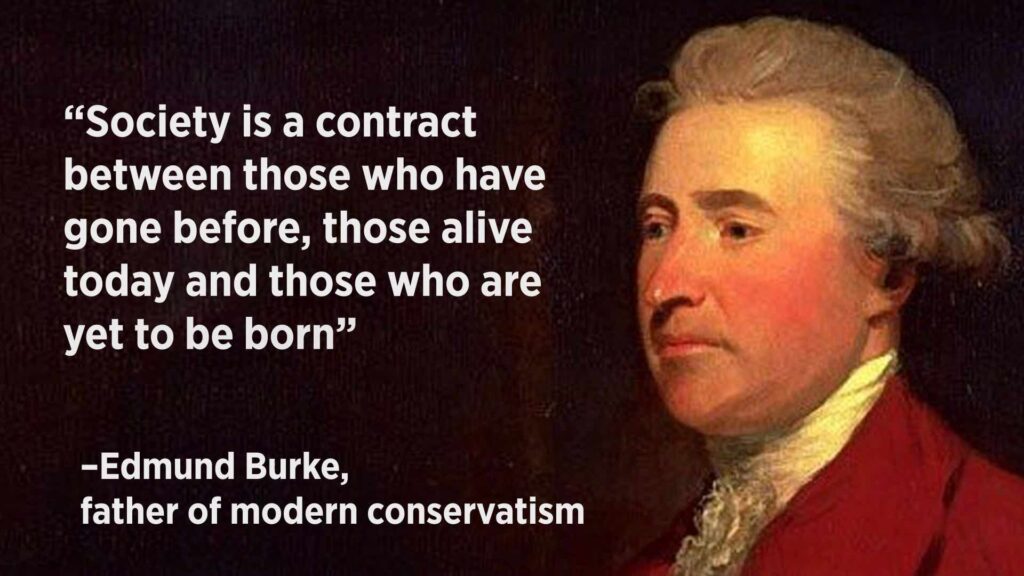
“Society is a contract, between those who have gone before, those alive today, and those who are yet to be born”
We should not be in doubt. The money that the government has borrowed to meet the needs of the current emergency does not come from nowhere.
It's borrowed from future generations.
Raising awareness of the need for Hawkesbury-Nepean River Health

The purpose of the visit was to raise awareness of river health, a responsibility I share as the Chairman of the Hawkesbury River County Council, which covers four Council areas and much of the river from Warragamba to Wiseman's Ferry.
We have specialised plant and equipment at HRCC which is essential to keep the river free of weeds, and were disappointed when the State Government pulled some key operational funding last year - just as we completed the salvage, refurbishment and recommissioning of our giant 'Weedosaurus' harvester with a $130,000 Federal grant.
My belief is that taxpayers, to say nothing of key river user groups like Rowing Australia, representing our Olympic team training on the river for the Tokyo games, expect the tiers of government to work together co-operatively to undertake this critical and ongoing work.
Minister Evans was a thoughtful listener and we gave him a detailed account of the effects of the floods earlier this year, the temporary reprieve it has given us as it flushed the river, and the short-sightedness of forcing us to sell our plant and equipment when weeds, like grass, will inevitably grow back. This is a warning I have delivered before.
The above story appears in this week's Western Weekender, and follows earlier coverage back in February.

Australian Councils deserve more help from the Federal Government
I'm down in Canberra at the 27th National General Assembly of Local Government, and it's been a valuable experience.
My head is swimming with statistics - the presentations have been excellent, covering the effects of COVID (both economic and health), initiatives to make communities more resilient, new technologies that aid in planning, communication and environmental protection. Enough for several other posts, but here are some headlines:
In 1996, Financial Assistance Grants - the main way the Federal Government assisted Councils, was 1% of Federal taxation revenue. Now, it has declined to only 0.55%, half of what it used to be. Despite the annual feeding-the-chickens announcements we're used to (like the very welcome boost to the Local Roads and Community Infrastructure program), support from the Federal government to Local governments has declined in real terms for decades.
Councils, through levying rates and charges, take in just 3.2% of ALL tax in Australia. Yet we're responsible for 32% of all public infrastructure, including 75% of roads.
COAG - the Council of Australian Governments, was founded in 1992 and was traditionally the table where all the tiers of government sat down. When that was replaced by the 'National Cabinet' last year, Local Governments were no longer at the table, and right at the time when our voice needed to be heard the most as COVID hit.
That's why I'm here. To learn, listen, and advocate for a better deal.
Saving Council money by trimming Councillor perks
At last night's meeting of Hawkesbury Council I presented a Notice of Motion to review our 'Provision of Facilities to Councillors' policy. The text of my motion is at this link.
When I was elected to Council in September 2016, I was surprised to be given a Windows laptop, a new iPhone with a SIM card, a printer, and a wireless modem & router to facilitate Internet access at home.
I didn't need or want most of these resources. I handed the laptop and iPhone back, and have never used the wireless modem router. Some of my fellow Councillors did the same. Representing the community is a privilege, and I was happy generally to use my own resources for Council business.
Frankly, the current policy is both wasteful and outdated. It refers to installing extra landlines and fax machines in Councillor's houses. It refers to arrangements for receiving a tape (an actual tape!) of Councillor meetings, even though we've been podcasting meetings for years.
I felt that the least we should do is update this policy so that the new Council elected in a few months are asked first what resources they may need – hopefully in the expectation that this will save ratepayers some money.
The motion was passed unanimously, which was very pleasing.
A new policy will be drafted and placed on exhibition for adoption before the elections in September.
Proposed McGraths Hill motel development knockback prompts litigation
Those driving down Windsor Road from Windsor will be familiar with the former but beloved Millers Nursery (a.k.a Windsor Garden Centre) on the left hand side on the corner of McGrath Road at McGraths Hill.

Opened by Ross and Lynette Miller in 1969, and carried on by daughter Bec it was a stalwart local business for 47 years. I remember it as a cosy and personal ramble – a place with nooks, and curios, and proper service. Not at all like the bland 'big box' nurseries that prevail now. Ross was active in Windsor Rotary for many years. Sadly, the business closed and the property sold in July 2016. The site has lain empty and sad ever since.
I mention this today because the fate of this site reveals in microcosm two things: The first is how Hawkesbury Council still has a long way to go to be a responsive, efficient public body that meets deadlines and applies our planning codes consistently. The second is how planning laws imposed by the State Government have disconnected the community from knowing much about, or having much say in Development Applications.
In 2017, the NSW Government instituted Planning Panels to determine DA's, removing the decision-making powers of elected Councils across Sydney. Planning Panels consist of unelected appointees who may have subject expertise in planning, but who are not democratically accountable to you, the citizen and voter. I and many other Councillors, including some Liberals were opposed to Planning Panels, and I've spoken at length about them before, including with 2GB's Ray Hadley.
A series of DA's have been lodged for the old nursery site to become a motel development. A pre-lodgement meeting held with Council in February 2018 indicated a desire to build a $10.8 Million, 130 bedroom motel.
DA0235/18 was lodged in May 2018 proposing a 94 room motel.
A decision on this proposal now sat with the Sydney West Planning Panel, with Hawkesbury Council staff writing a report with a recommendation for or against.
Council's report to the Planning Panel did not arrive until September 2019, over a year later. This kind of delay is itself an issue for me. Such determinations should not take so long. In October 2019 that application was knocked back, for a variety of reasons including the ability of the McGraths Hill sewerage treatment plant to cope with the load the development would place on it.
The applicants then came back with a new proposal for an 80 room motel under DA #0130/20, lodged on 13th May 2020.
I suspect not many people, even residents of McGraths Hill, knew much about any of these proposals.
76 days later, on 28/7/2020 the applicant made an application to the Land and Environment Court (case #2020/00226591) to litigate the DA on the basis of an assumed "deemed refusal", which means that the DA was not finalised or determined either way within the prescribed assessment period (which can be either 40 or 60 days).
Recently, on 31/5/2021 the application was withdrawn and a request for a refund of DA fees made, but only because this litigation was, and remains pending. A hearing may not occur until September.
In their letter withdrawing the DA, the applicants offered this stinging commentary to Council:
"It is with disappointment that we note that a lack of transparency from Council in relation to Council’s sewerage capacity issues and a lack of response from Council officers (who are too busy) in relation to the proposed on-site waste water system - which have prevented us assisting to achieve a satisfactory resolution of this development proposal."
I offer no commentary on the merits of the proposal, except to note that all applicants to Council are entitled to prompt and professional service within "best practice" assessment timeframes. If they didn't get it, I'd want to know why.
But my broader point is that, when decisions that shape the character of our neighbourhoods are taken away entirely from your elected Councillors and given to planning panels, the community ends up poorly informed (did you know about this?), and decisions are taken that you can't require anyone to be accountable for, and that's not good enough.
The NSW Productivity Commission White Paper and Local Government
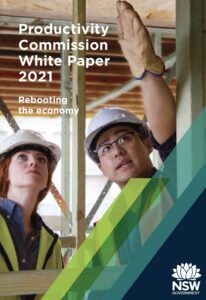
Being a good local government representative means understanding the landscape that Councils inhabit, and the way we interact with other tiers of government. So, it's well to pay attention when the State Government announces potential shifts in policy.
Constitutionally, Local Government does not exist. This is despite a decades long campaign, which I support, for constitutional recognition. There was a failed referendum in 1988. More recently, the Labor federal government promised another in 2013, which I believe would have passed with bipartisan support, only for them to welch at the last minute.
I've always believed in the principle of subsidiarity, which suggests that decisions in government should be taken by the level that is closest to the people affected. In my opinion devolution, rather than the endless accumulation of power to higher or more centralised authorities, is not only more efficient, more democratic, but also more consonant with classical Conservative principles of government.
However, any administrative or regulatory function held by government has to be paid for. Unfortunately, 'cost shifting' has moved the responsibility for a huge amount of regulation, infrastructure, planning and service delivery - previously provided by other tiers of government, on to local Councils like ours, and thus to our ratepayers, without the ability to pay for it. A 2018 LGNSW report concluded this cost NSW Councils (and again, ratepayers) over $6.2 Billion of extra costs between 2006 and 2018. Hawkesbury Council estimated the cost to us was $6.9 Million in one year alone.
So against this backdrop, I was interested when this morning NSW Treasurer Dominic Perrottet launched the NSW Productivity Commission's 'White Paper' into rebooting the economy. I tuned in for the Treasurer's speech. The report makes for interesting reading, and I'll pick just a couple with relevance to Councils like ours.
One graph in it shows how the 'rate peg' has suppressed local government income since it was introduced in 1993.
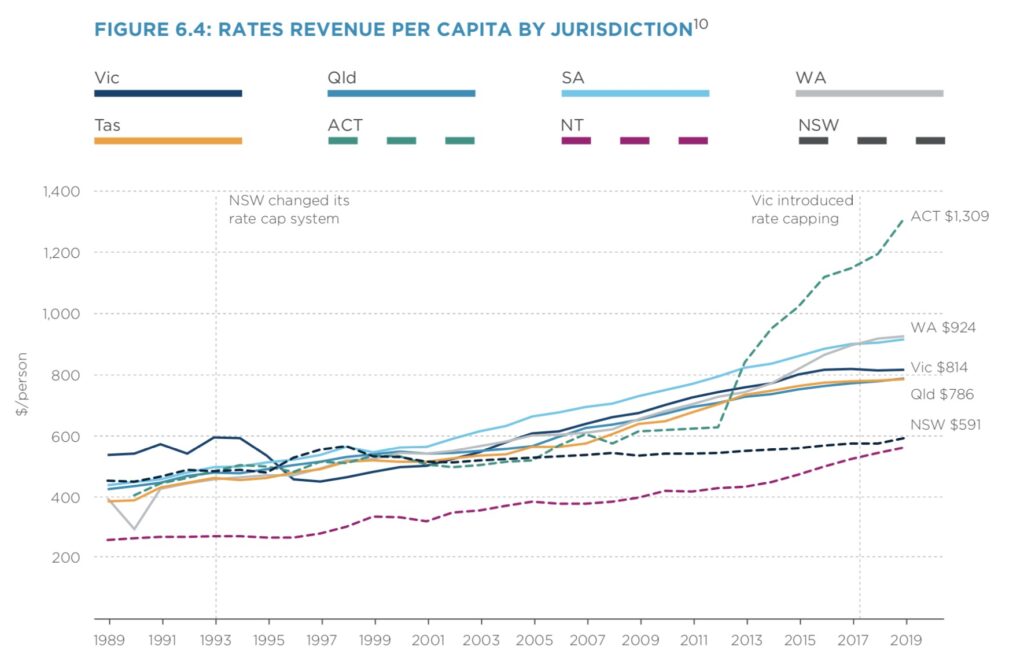
This presents a mixed picture. In my time on Hawkesbury Council, I have been strong on ensuring Council lives within its means. I opposed the rate rises the dominant ruling block imposed on the community, as well as the changes to the rating formula that concentrated the rating burden unfairly on particular ratepayers.
But it also shows that this government policy has deprived Councils across the state of the ability to grow their revenue to pay for cost-shifted responsibilities in anything like the way Councils have in other states, to keep pace with inflation, population growth, or rising regulatory or infrastructure costs. The White Paper suggests that the rate peg should be abolished, or at least varied to allow Councils to better account for population growth.
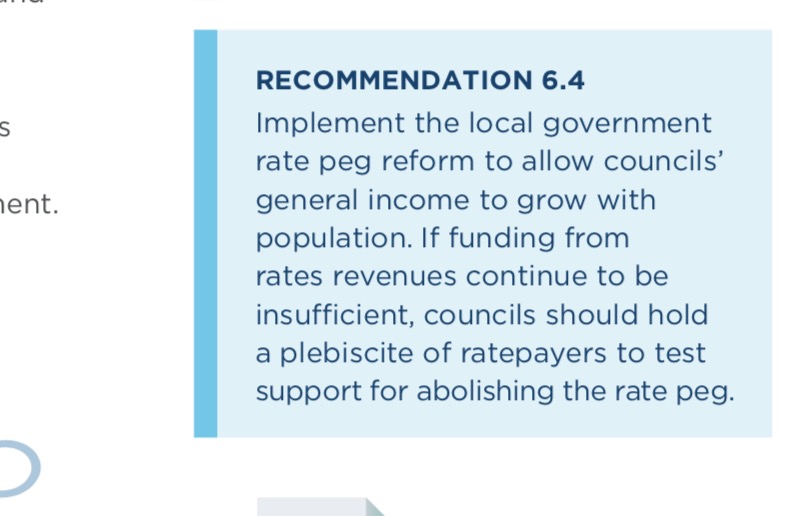
No one wants Councils to overcharge their ratepayers. Equally, most people agree the State government cost shifting to Councils without providing the revenue to pay for it is unfair. Any policies flowing from the White Paper will need to ensure that abolition of the rate cap doesn't act as a green light for Councils to just jack up their rates. I think most people in the Hawkesbury don't think Council is doing the best with what they are already collecting.
The white paper also suggests that Councils should to abide by principles of 'competitive neutrality', when it engages in commercial conduct that may disadvantage other local businesses that operate in the same domain. The example it cites is Councils that run Child Care centres. As it happens, there are nine different child care centres operating in Council owned properties around the Hawkesbury, who enjoy a substantial subsidy. This report presented to Council in October 2018 says it best:


The white paper makes this recommendation on p169:
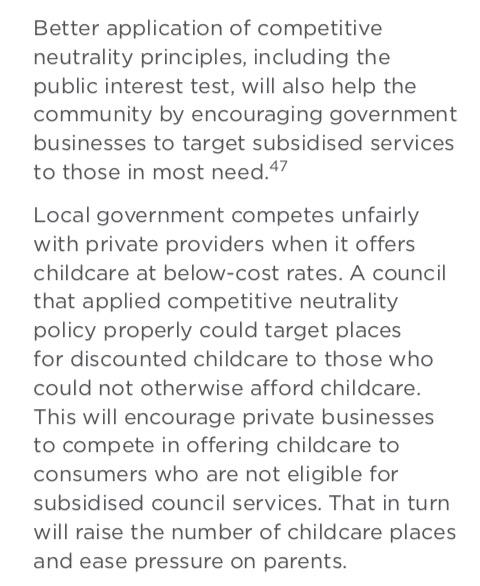
My own view is that the various childcare centres around the district are worth supporting, and the 'subsidy' of facilities run from Council properties (effectively, an opportunity cost to Council in terms of foregone revenue) provides a direct and valued support to the community. I believe Council addressed the issue of centres taking an unfair advantage over their fully commercial competitors when it inked an agreement to ask those providers to contribute to a multi-year 'building renewal fund' to acknowledge the benefit they received from operating from Council properties, amounting to $1.5M over the life of the agreement.
I am glad that the NSW Government has been so effective in supporting our State economy during the worst economic dislocation for generations. This White Paper is not a policy manifesto, nor is it legislation. It's the start of a conversation, and a very timely one about how to continue economic reform and streamline co-operation between local government and the State.
Oakville Oval needs an upgrade

Oakville Oval is one of 23 different playing fields, and one of the 215 parks and reserves around the Hawkesbury.
I've been a user of the oval all my life. I remember attending Oakville Public School sports carnivals there as a boy, kicking about kerosene-soaked fireballs when I was in Oakville Scouts (probably an OH&S nightmare now), and now witness my nephews play there as a soccer uncle.
Given the amount of use by the community, I feel Oakville Oval is looking a little tired and needs some care and investment.
Upkeep and development of our sporting fields is managed by the Hawkesbury Sports Council, who maintain two and five year plans for all local Ovals. In preparing those plans the Sports Council seeks submissions from sporting clubs and users of specific ovals. I was surprised to learn that, at the time the last plan was drawn up, no responses were received from the clubs that use Oakville Oval. I strongly encourage them to make a submission for the next round that will be called for the 2021/2022 financial year, and will be reaching out directly to make that appeal.
Council is aware of the increased use of the oval particularly during winter sports and the increases in parking and traffic. We've all seen the cars spilling on to the road, and the 'car park' is really just an abandoned gravel depot that turns to mud in poor weather.
The Sports Council advise that other suitable ovals in the area are used in conjunction with Oakville Oval wherever possible to spread the sporting community’s needs across the city.

I've always thought that using shipping containers to store equipment like rollers, goal posts and nets is ugly and less optimal than lock-up colourbond sheds on slabs with roller doors. However, I am informed shipping containers are considered a better alternative due to their sturdiness and they deter vandalism due to their locks and wall thickness. If you have a different view, please let me know.
Currently there is one shelter area at the Oval and some seating available around the canteen building. Due to the high level of use for various sports there isn't much room to install further shade areas without impacting on the current uses. There is also damage from the shade trees occurring to the on-field area in front of the containers as this area gets no sun. I am told that planting of additional trees might only compound this problem.
Hawkesbury Sports Council have planned to upgrade the irrigation system this year due to the field having to be returfed each year due to increasing use by the soccer club. Following the recent floods and damage to other grounds, the Sports Council has voted to place on hold all capital works until such time as the financial effects of the flood is clearer.
The Sports Council assigns its works program across all sports grounds and prioritises these as required. Where grant or other funding opportunities become available Council and the Sports Council will seek funding for upgrades, including the car park area. In addition, Council is currently planning for the development of Fernadell Park in Pitt Town. This development is subject to funding however, once developed, it will provide additional fields that can be used by the local sporting clubs and reduce demand on Oakville Oval.
Council will ultimately prepare a full masterplan for this and other reserves. I will be continuing to call for a long term plan, and sustained funding for improvements, on behalf of the residents and users who gain enjoyment and use of Oakville Oval.

The Hawkesbury Floods, March 2021
Some times it must feel like our community can't cop a trick. Devastating fires, pandemic and two floods, all within a 16 month period.
Yet again, out of the distress and destruction of property has arisen the real spirit of our local community, which has rallied magnificently. The response of our SES, Police and RFS have been truly heroic, and they deserve our respect, as do those who just help because it's the right thing to do. Neighbours help neighbours. It's the Hawkesbury way.
I tried to document the effects of and responses to flooding by visiting as many places and people as I could. These videos have apparently reached over 111,000 people on social media.
Since the waters have receded, I've been honoured to be present variously at the visits of the Governor General David Hurley, The Premier Gladys Berejiklian, Deputy Premier John Barilaro and Minister for Roads Andrew Constance.
It has also brought the need to raise Warragamba Dam back into focus.
The plan to raise the dam is about the safety of the community – the 134,000 people who live and trade on the Hawkesbury-Nepean floodplain. It isn't about development, or Sydney's drinking water supply. Nor should the debate be unduly focused on the temporary inundation of uninhabited bushland around lake Burragorang, for a week or two, once or twice a century.
The Resilient Valley, Resilient Community flood risk study released in 2017 explains 75% of our flood risk comes from the Warragamba catchment. It also points out that raising the dam would reduce the severity or frequency of bad floods by the same proportion – 75%.
Floods have already been averted or reduced by Warragamba, under certain circumstances. Severe rain events that began at the time of the early 1990s flood, when the dam was depleted to about 46% capacity, lowered the subsequent level of waters of on the floodplain by over three meters. This is the kind of 'accidental' mitigation that needs to be built into the dam permanently.
It really disappoints me that some of the commentary from people opposed to the project is so dishonest. This recent article in the Blue Mountains Gazette, and the comments of ex-Minister Bob Debus should anger everyone at risk of flooding, especially because he, like other opponents of the dam raising are usually high and dry and out of harms way. Our community in the Hawkesbury bears the brunt of this risk. I've pointed this out on many occasions.
Over the last fortnight I have stood with many people who have lost their homes and possessions because of Mr Debus' inaction in the 1990s, when there was a plan to raise the dam by 23m. The Labor government's decision not to treat this as a bipartisan issue and scotch those plans, which were shovel ready when Bob Carr was elected in 1995, is partly responsible for the damage this flood has caused.

Mr Debus says raising the dam won't prevent all floods. But wearing a seatbelt won't prevent all car accident fatalities. Backburning won't save every house in a bushfire. But only an idiot would argue against doing what we can.
Imagine if the present floods had been 3 meters lower as a result of being able to hold back 1000 gigalitres of that water for long enough to allow them to drain away.
When Mr Debus only notes the quarter of floods that result from rain in other tributaries, he's misleading you. And he's wrong to state that permanently lowering the dam levels by 10m is the same as raising them by 10m, because of the tapered shape of the dam. The bottom 2cm of a wine glass holds much less than the top 2cm.
And pre-emptively reducing water levels in the dam, which every armchair expert has advocated over the last fortnight would (literally) be a drop in the ocean.
The topical unit is the 'SydHarb' - A Sydney Harbour's worth of water, or about 500 gigalitres. Warragamba can hold 4 Sydharbs, and the dam raising project will add another 2. I was talking about this a decade ago. Lowering the dam to levels that would imperil Sydney's drinking water supply to create a buffer would have taken weeks, and would account for maybe 0.2-0.5 Sydharbs.
In comparison, the inflow of water resulted in a Sydharb *per day* topping the dam for 2-3 days. If we could have absorbed two days of that inflow and let it out over a week or fortnight, many of the grieving people who have lost their homes, goods or livelihoods would have been spared.
Lastly, Bob raises the debunked-a-thousand-times canard of development on the floodplain. The 1:100 flood height buildong controls will not change. Not a single square meter of land which is presently sterilised by these controls would be opened up for building in the event of raising Warragamba. And the only time any flood has exceeded the 1:100 level in the last 222 years was in 1867, showing this is a reasonable safety measure. The sad fact is that the 5,500 houses built below the 1:100 level were built before those flood height controls were implemented.
Damn you, Bob Debus, for your reckless conduct as a Minister - when you actually had a chance to do something about this, you sat on your hands.
I spoke to the media on several occasions to represent our at-risk community
Print stories: Central News (18-11-2020), ABC (27-3-2021), AAP (23-3-2021), and TV as below:
It concerns me that in each of these cases, the voice of the community at most risk is not emphasised in balancing the costs and benefits of flood mitigation.
An excellent book I have at home on the history of the construction of Warragamba Dam in the 1950s is subtitled "Thank God there were no greenies." I worry that an inability to soberly judge the necessity of flood mitigation will eventually cost lives, when a flood bigger than this one finally comes.
Nature has given us a warning. Are we wise enough to heed it?
Is your energy retailer denying you a smart meter?
In October 2014, the then NSW Minister for Energy Anthony Roberts announced a rollout of Smart Meters for all NSW homes and businesses. He said:
“The market-led rollout of smart meters is the NSW Government’s next step in putting the power firmly into the hands of electricity customers.”
Seven years on, this market-based approach has resulted some of our larger electricity retailers dropping the ball badly. I'm singling out Origin Energy, who have annual revenues of $15 billion and over 4 million customers.
This is embarassing. In Victoria, they completed their rollout of Smart Meters by 2004.

Overseas, the UK is well along in a rollout of 3 million smart meters. The EU's goal is to provide smart meters to 80 per cent of consumers. France has committed to install 35 million meters as part of a $A19.7 billion spend, and the the Chinese government are deploying up to 380 million of them.
This isn't good enough. With a Smart Meter, you can monitor your energy consumption using a smart phone app on a much more granular level.
I badgered Origin to give me the Smart Meter the scheme promised 7 years ago, and they grudgingly did so as a one off.
The precedent neatly set, watch this video to see how you can demand the same. Yes, they probably will be annoyed, but it's time they did the right thing.
A big win for Oakville residents

After nearly five years of banging on about the shocking state of our local roads, I was very pleased at Councils meeting of 30/3 to be able to negotiate additional funding to FINALLY SEAL Old Stock Route Road and Brennans Dam Road at Vineyard.
Most of this is new money, and was absolutely not on the table before.
Some additional commentary:
• Unfortunately this does not yet seal the Commercial Road approach.
• The culvert will have some drainage and scour works done, but will remain a single-lane crossing for now.
• I couldn't get the whole package of works through tonight, both because of our inability to complete the whole project within the deadline of the Commonwealth grant (31 Dec 2021), but also because I could not get more than this through the Chamber (for now).
• Further stages to fix Commercial + widen the culvert have been costed (~$450K) and I pledge to return to these ASAP.
• Yes, this road floods. Regularly. However, when natural disasters strike we get 100% coverage from the State Government to restore these roads but only on the basis of a 'no betterment clause', meaning we can't use disaster relief funds to improve a road beyond it's previous state. If however we improve it now, future damage will be covered to this new better standard. Some of the drainage works will help prevent road erosion against future flooding.
THANK YOU to my Hawkesbury Liberal Team Council colleagues and other Councillors who voted for this, especially those who reversed their previous opposition. Not everyone did...
Sending a strong message about inappropriate development at Kurrajong and Kurmond
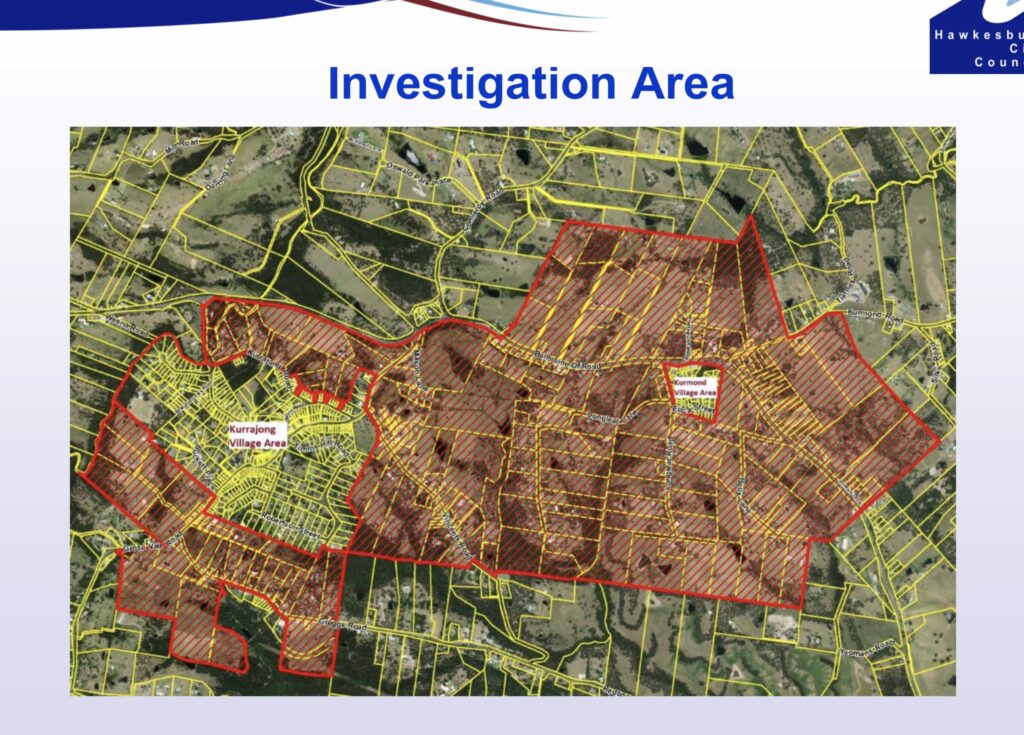
At Council's meeting this week, I supported a motion to end the ‘Kurrajong-Kurmond investigation area’ process.
I believe the proposed rezoning and adoption of the 'Structure Plan' would have encouraged the lodgement of further subdivision proposals. I felt it would have sent a message to landowners or developers that we were encouraging subdivision west of the river.
The motion Council passed abandons either rezoning or the Structure Plan, adding that Council 'Not encourage the lodgement of additional individual Planning Proposals within the Kurmond- Kurrajong Investigation Area for rural residential development.'
The motion ensures already-lodged planning proposals will be granted due-process, and continue to be assessed against relevant criteria.
A 2017 survey of Kurrajong and Kurmond residents showed that only 32% of residents supported developing the whole investigation area.

Although it is true that anyone can submit an unsolicited proposal at any time to subdivide their property, they will still be assessed against increasingly strict criteria of both our LEP and the Greater Sydney Commission's residential strategy.
Two Councillors recused themselves because they or their families, live or own property in the subject area, including Liberal Sarah Richards.
Extraordinarily, the Greens and Independent Councillors voted not only to adopt the structure plan, but to have Council prepare a planning proposal to rezone the land identified in the plan.
We encourage those with an interest in the debate to listen to the Council webcast.
Facebook and the survival of rational democracy

So after two days of Facebook gaol, my Councillor Facebook page, the Hawkesbury Liberal Team page, and the Hawkesbury District Independent Magazine page are back up, after Facebook purged thousands of Australian pages including charities, public health sites and not-for-profit groups.
However, at time of writing, the worthy Hawkesbury Post, The Hawkesbury Gazette, and the Hawkesbury Visitor Information Centre, which is a Council page, were still off-line.
What utter stupidity. Facebook can't even be consistent about what constitutes 'news'. Business students will one day write essays about how a $745B multinational trashed their branding in a stroke by citing this episode. It was a stunningly dumb move.
Here's what it boils down to. Many people choose to view their news through Facebook – for some it's the main way they keep informed. Spain and Germany enacted similar copyright reforms in 2014 – seeking to charge aggregators for the value news sites conferred them.
In that case it was Google who removed news from their site. Immediately, there was an overall 20% reduction in news consumption. People were less informed – a poor outcome.
Now, ask yourself: With social platforms only making belated and cosmetic efforts to remove inflammatory and misleading content, if there's suddenly no professional journalism or fact checking in people's feeds, then what's left?
That's right. Facebook becomes even more of a sewer. Less fact, and more garbage.
I'm not convinced that the Federal Government's proposed Media Bargaining Code is the right solution, but I am convinced that they have picked the right fight.
We have to recognise that in our system of open democracy, the role of a free and viable Press serves a critical role to hold the powerful to account. The 'fourth estate' provides a shared sense-making dialogue to society that helps us parse truth from flim-flam, scare-mongering and misinformation.
The eyes of the world are on us to hold our nerve – not unlike Australia pioneering plain packaging for cigarettes against a barrage of spurious lawsuits from the tobacco industry. We won that fight, and other countries followed our lead.
I've provided further remarks to the Hawkesbury Post. The link is here. And if you feel strongly about supporting smaller news media outlets, who seem to be locked out of the benefits of the Federal scheme, then make a donation to one here.
Hawkesbury-Nepean river suffers as HRCC endures cut to funding

As the Chairman of the Hawkesbury River County Council, I believe Hawkesbury residents get great value out of our association with it, which goes back to the HRCC's founding in 1948. HRCC looks after the health of our waterways. Ratepayers from the four member Councils contribute around 50%, which is ~$190K per year towards its operations. The rest comes from a variety of State and Federal grants.
In November, Local Land Services, a mid-level bureaucracy installed by the NSW Government to dispense funding, abruptly cut the funding that we were using for operational works (such as weed clearing on the river using our 'Weedasaurus', pictured above), by $238,000. Before LLS, we dealt directly with the Department of Primary Industries (DPI) and had a wonderful working relationship with them.
This will result in us laying off skilled staff, and potentially even having to sell the Weedasaurus, which would be frustrating given we only had it repaired and refurbished with $130,000 of Federal money after it pulled its mooring and sank near Penrith weir in the flood of 2020.
We have Olympic and Paralympic rowers training on the river now for the Tokyo Olympics. They are counting on us to keep the river free of weeds. Taxpayers expect better co-operation between tiers of government. How ridiculous to have the Federal Government generously fund plant and equipment only to find that the State Government drops the ball with operational funding.
I am calling on the State Agriculture Minister, Adam Marshall, to intervene.
Hawkesbury Radio interview, February 2021
This week I had the pleasure of sitting down with Garry Cotter at Hawkesbury Radio 899 to talk about my personal opinions on a wide range of issues.
The fate of a concrete recycling plant continues to be of concern to residents of Ebenezer, and I had an update concerning an upcoming planning panel meeting, along with remarks about the deficiencies of Planning Panels generally.
As a member of Council's Civics committee, I congratulated our Australia Day award winners.I put on my hat as the Chairman of the Hawkesbury River County Council and raised a concern that key aquatic weed control activities are at threat because of a bad funding decision by the NSW Government.
I spoke about some very recent changes to a proposed 580 lot subdivision at the Jacaranda site (off Kurmond Road at Glossodia).
Finally, I spoke about the ongoing pressure for development in the Oakville, Vineyard and Maraylya areas, and efforts I've made to consult with that community.
Timecodes:
0:00 Concrete Recycling Plant, Ebenezer, and Planning Panels
8:06 Australia Day award winners
10:01 Hawkesbury River County Council, State Government Funding fail
16:34 Council Committee Restructure and the Heritage Committee
21:24 Proposed Development at Glossodia -Jacaranda
28:00 The Pressure for Development in Oakville, Vineyard and Maraylya


